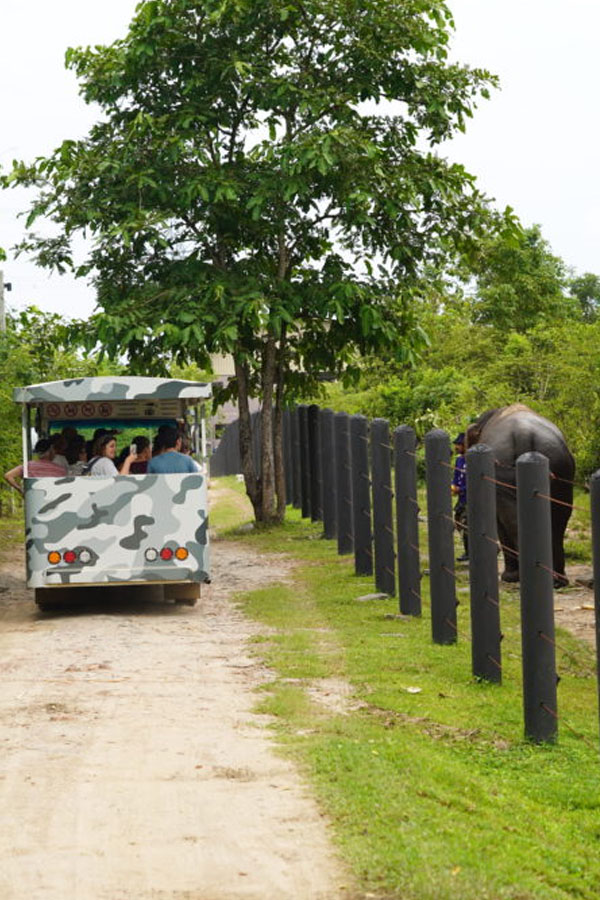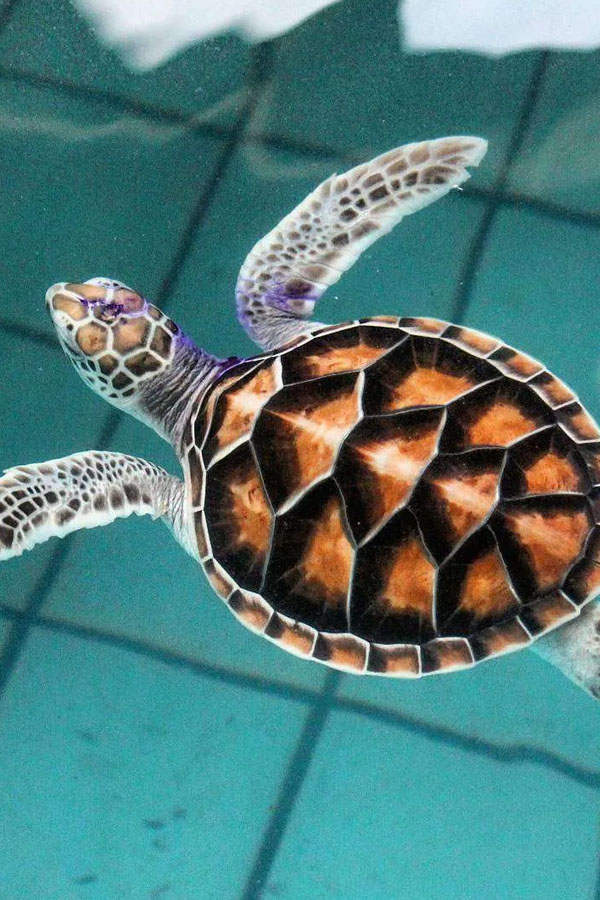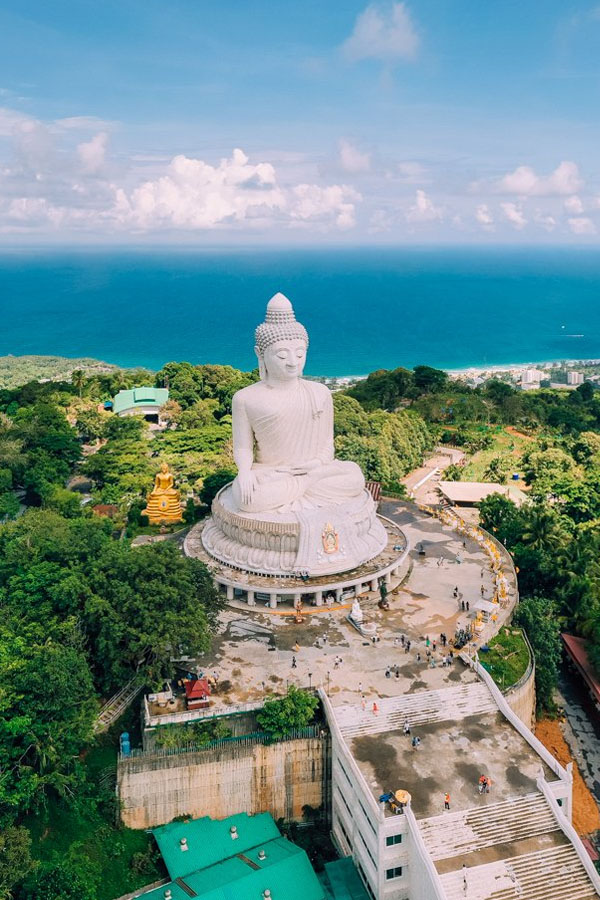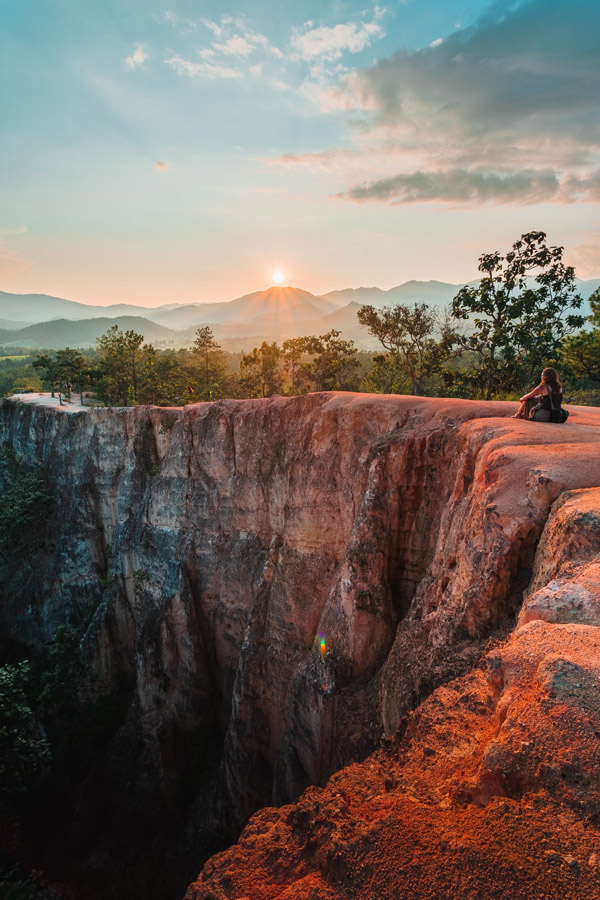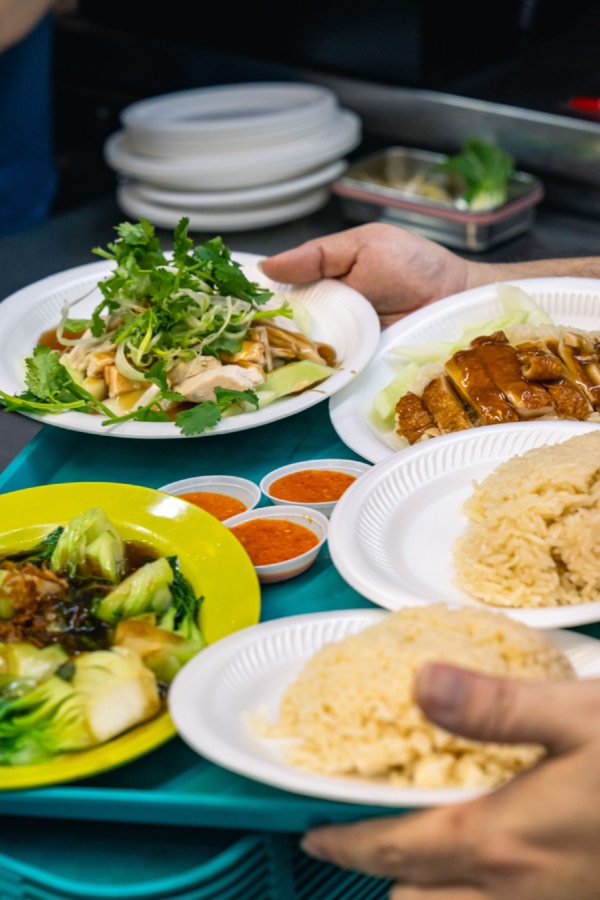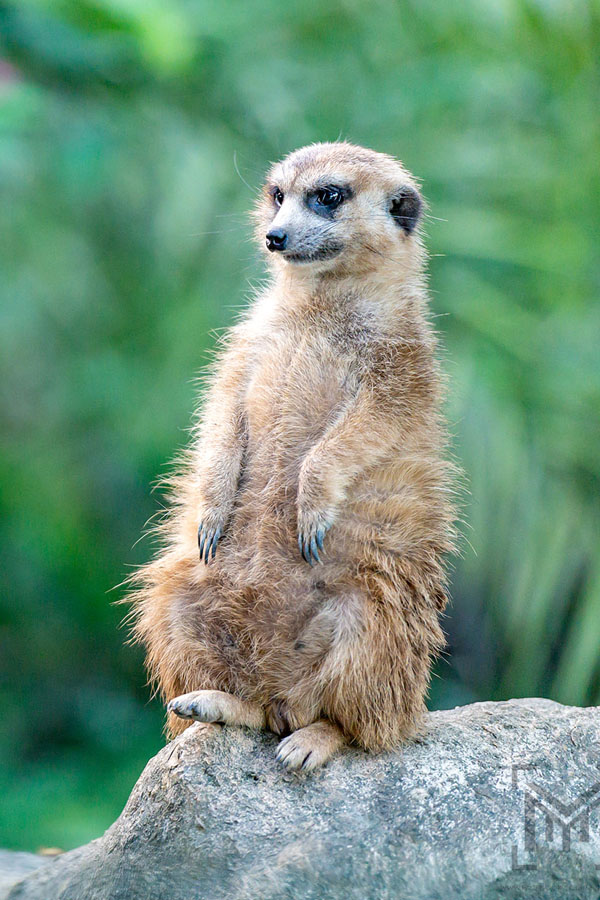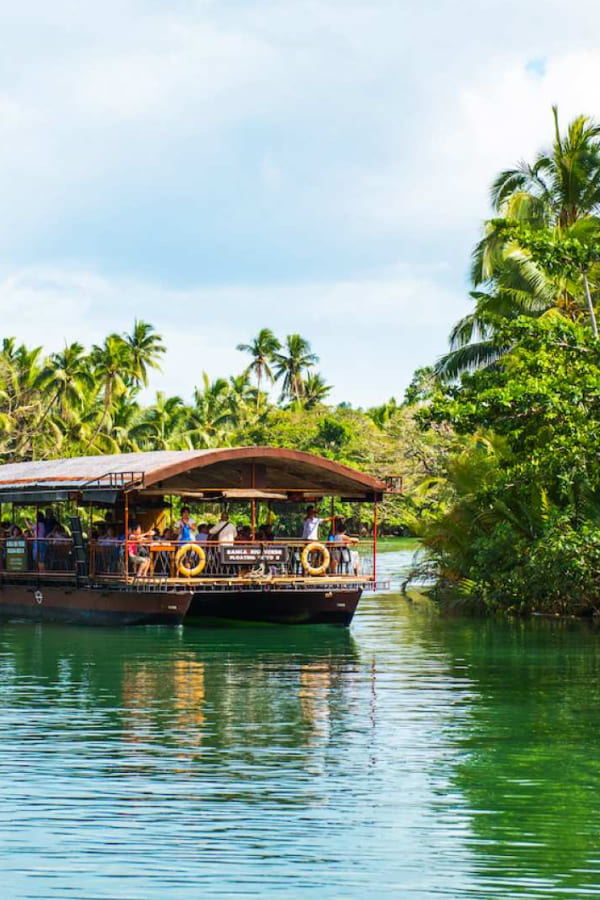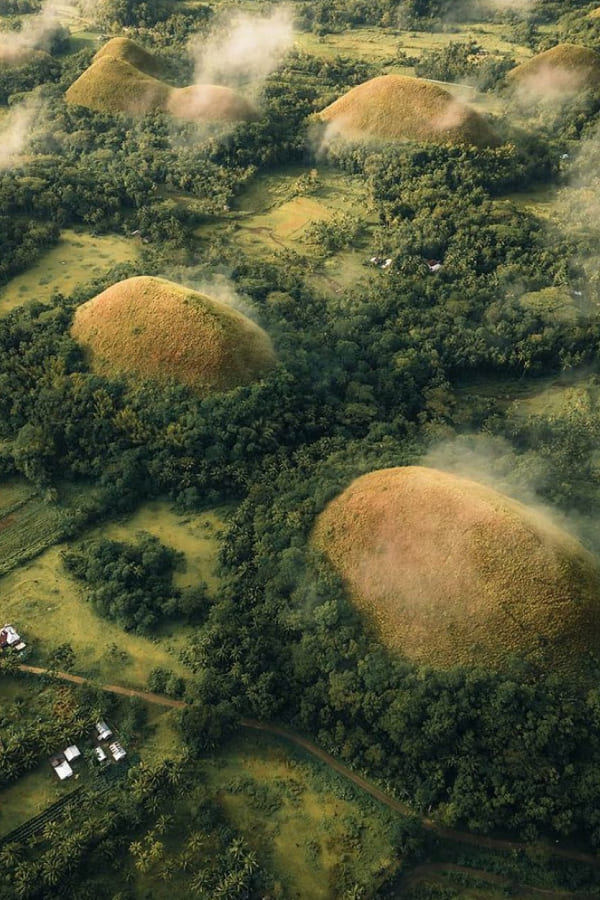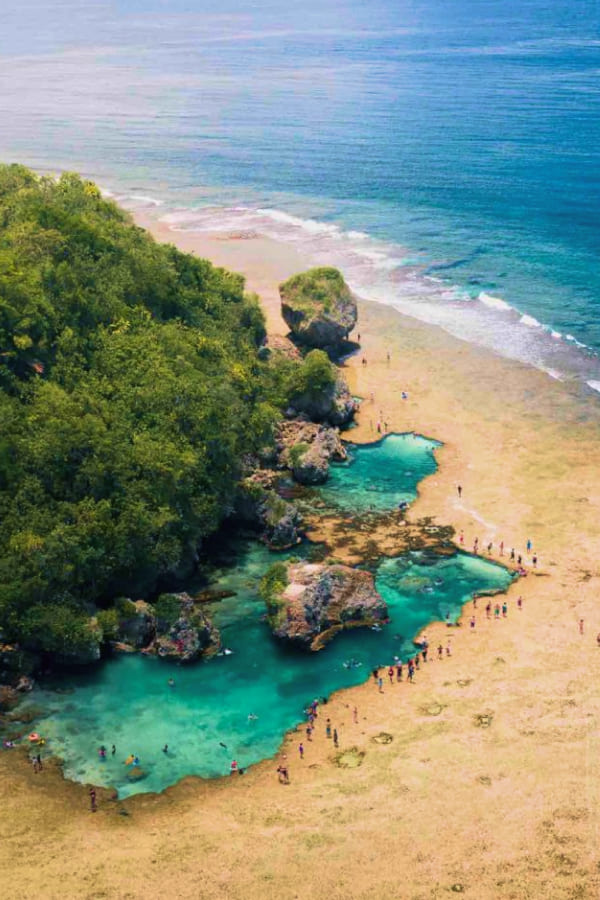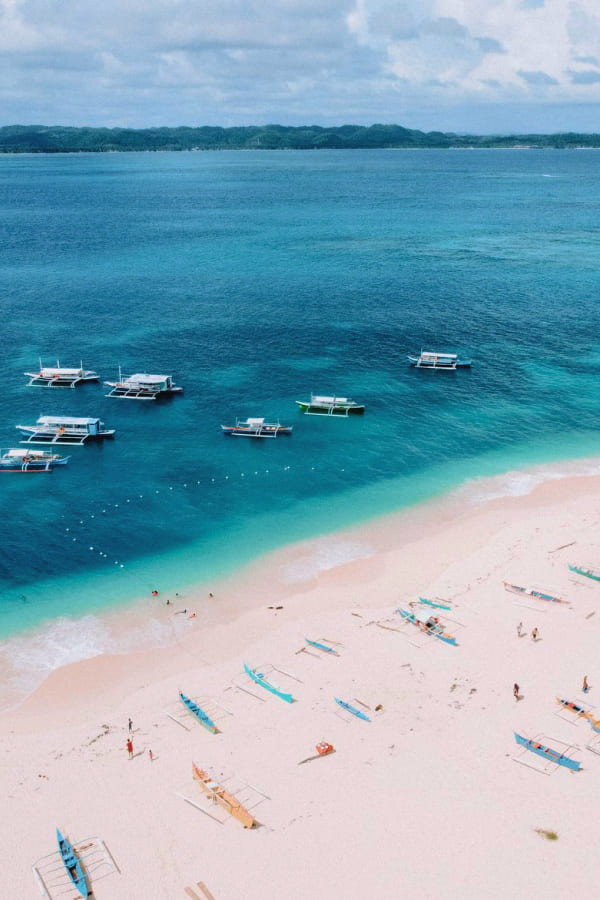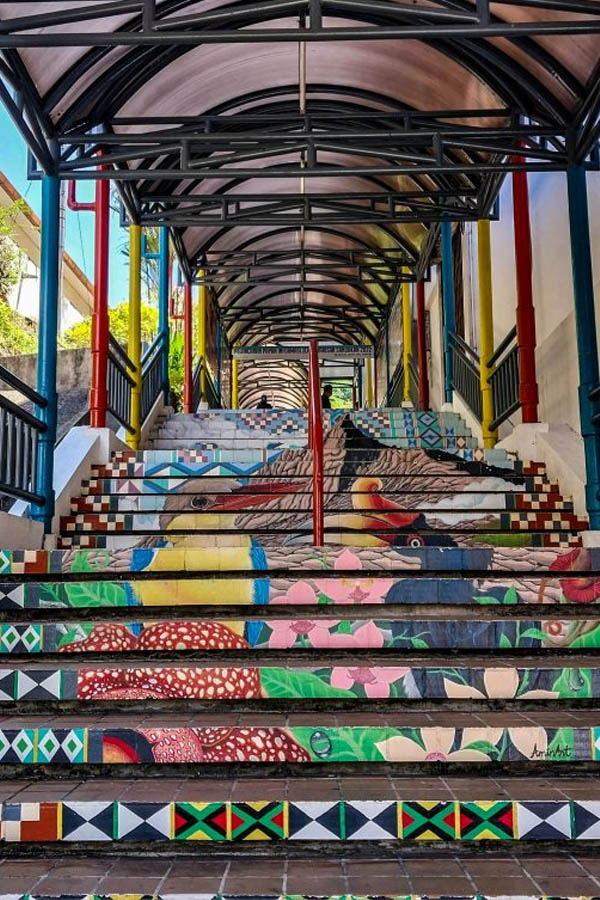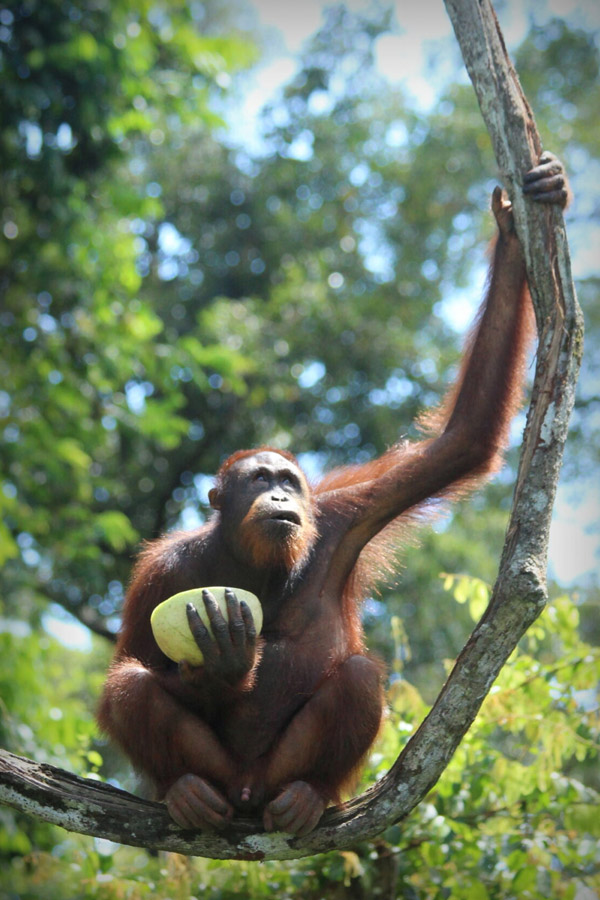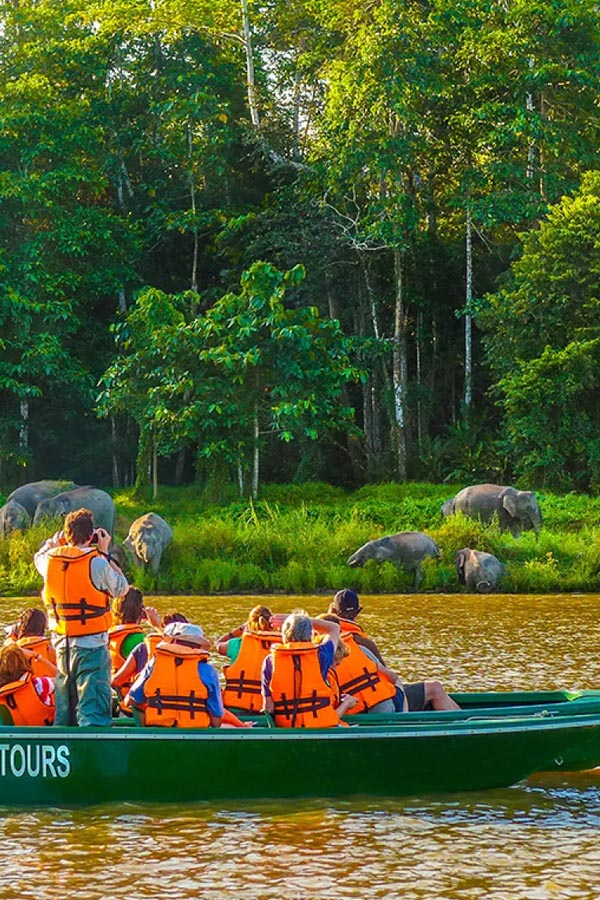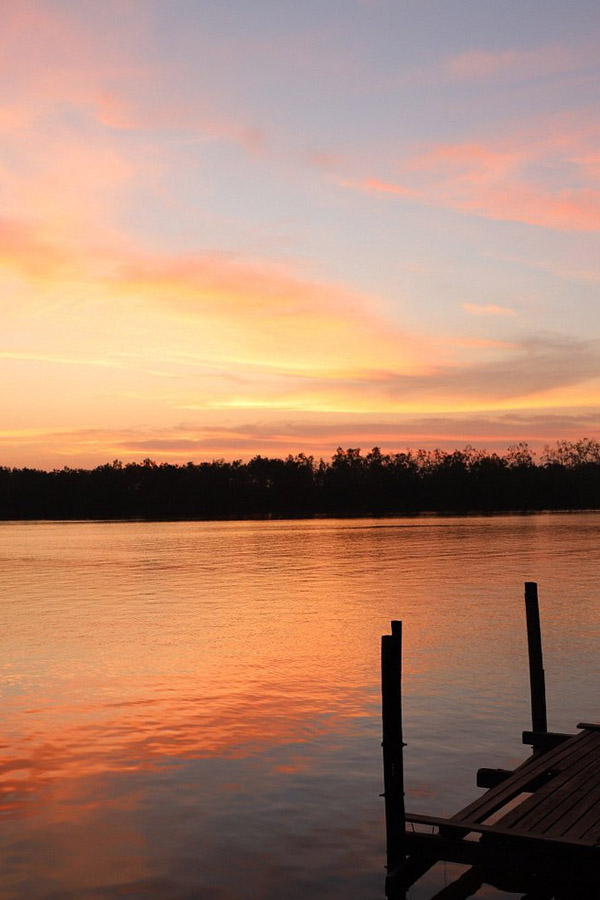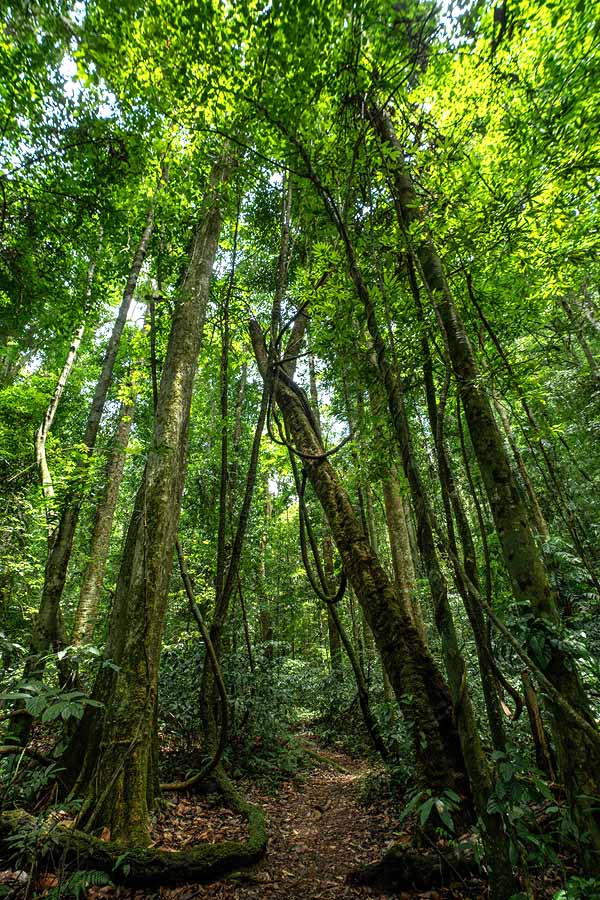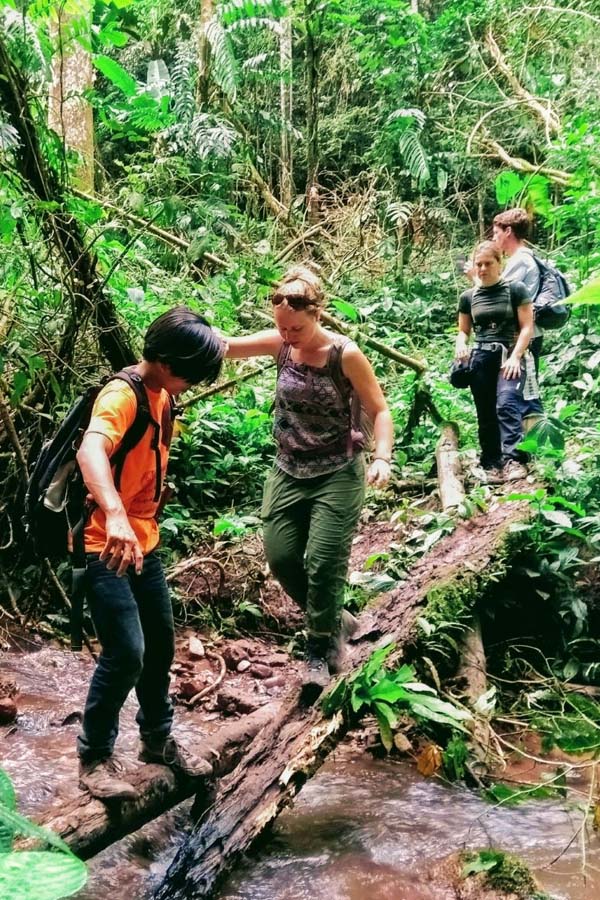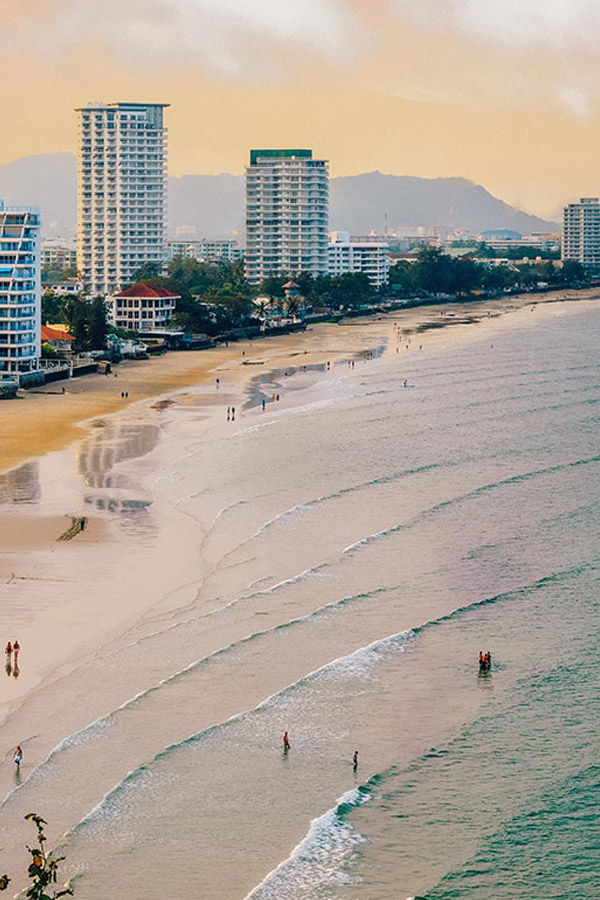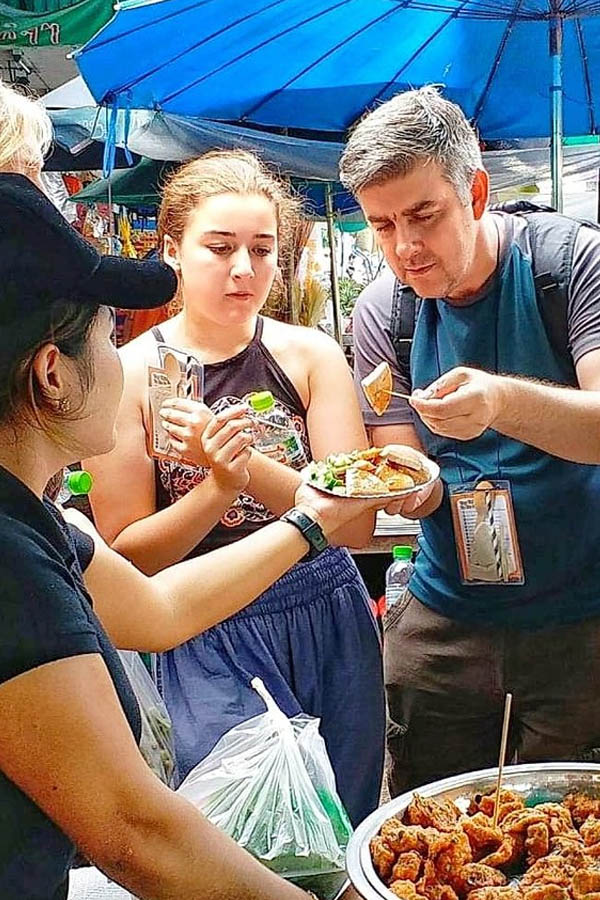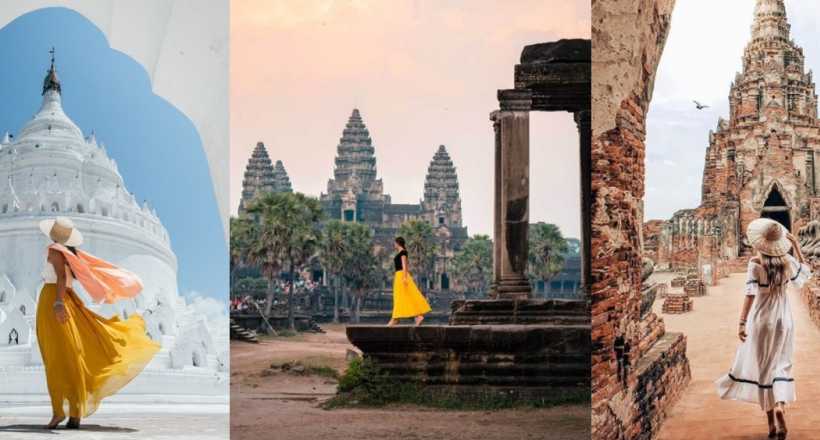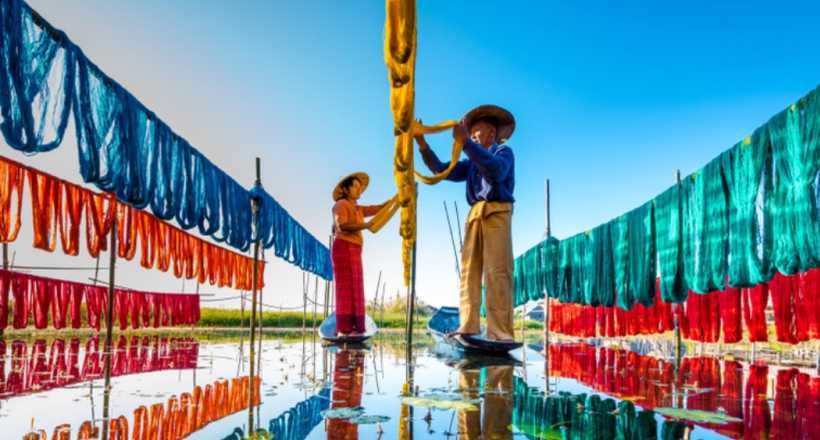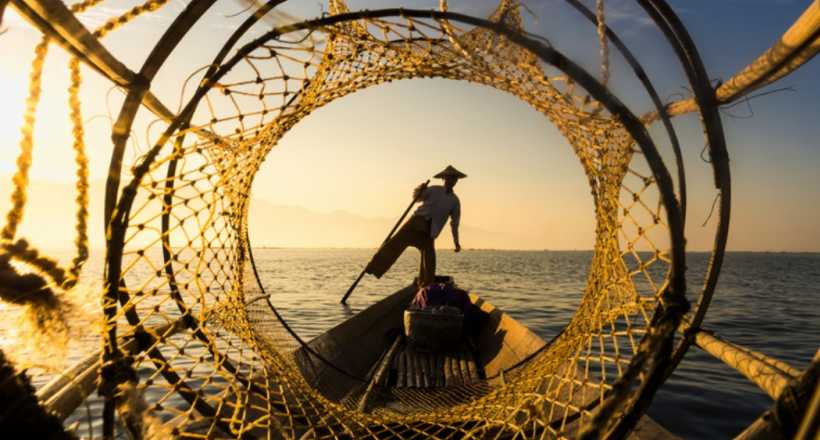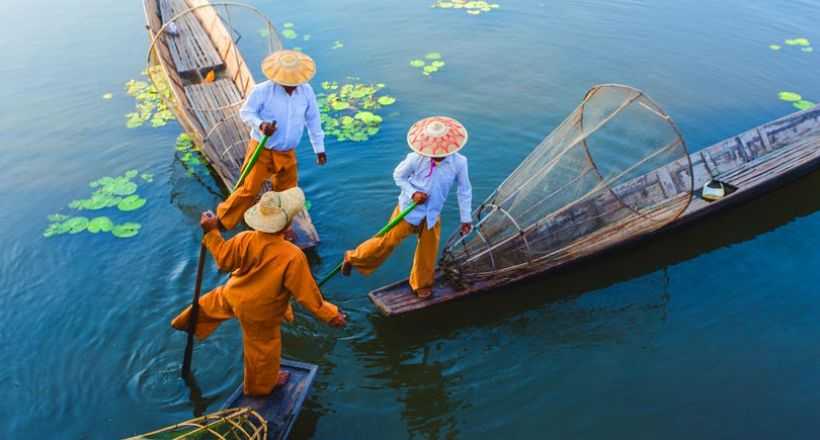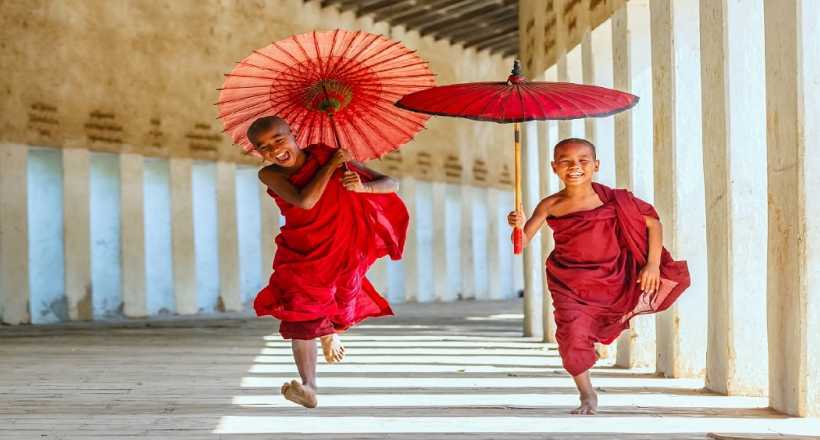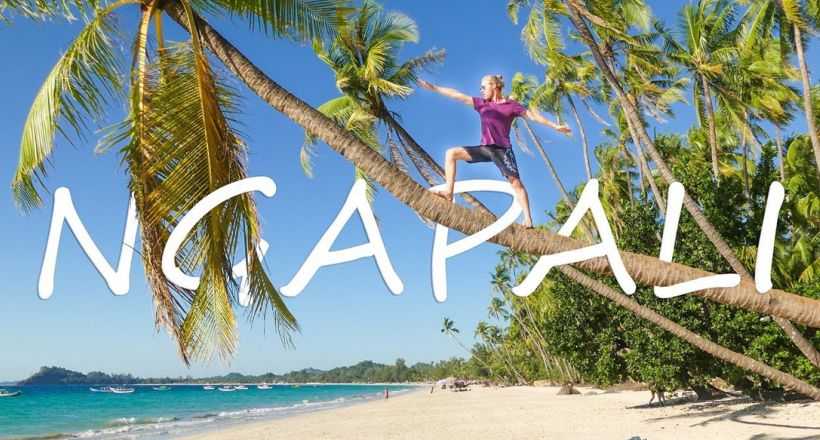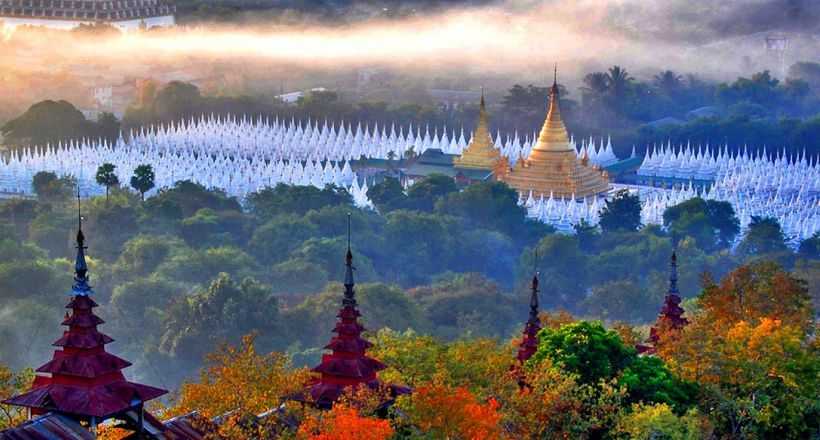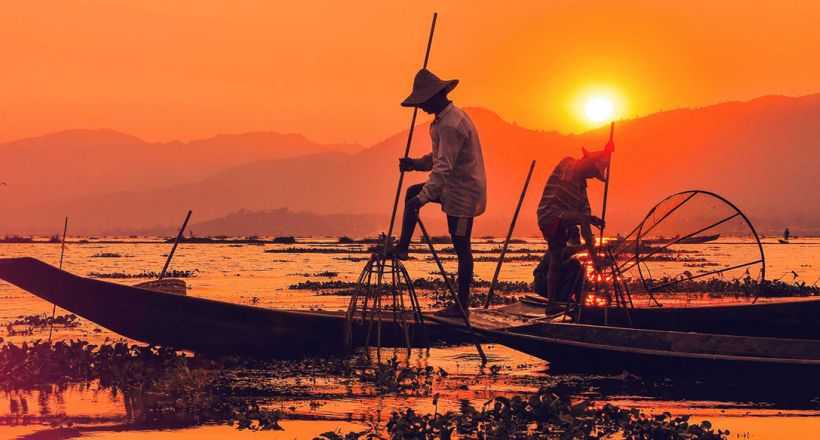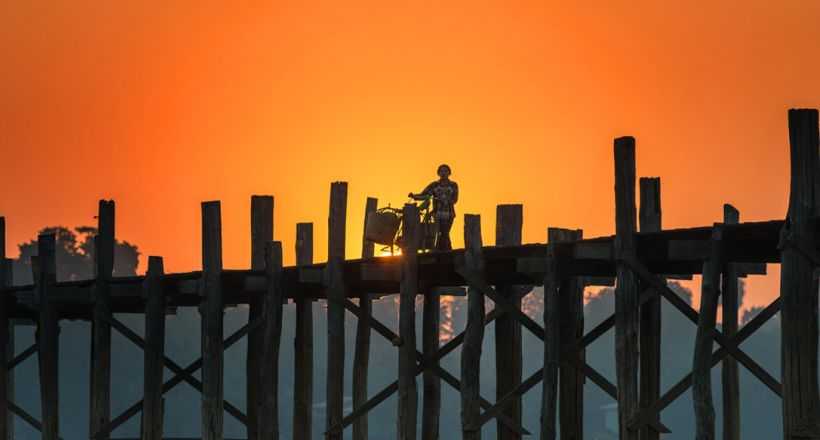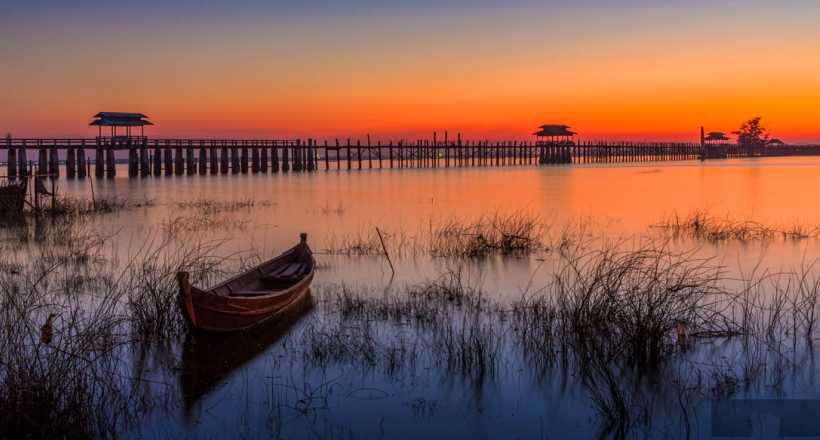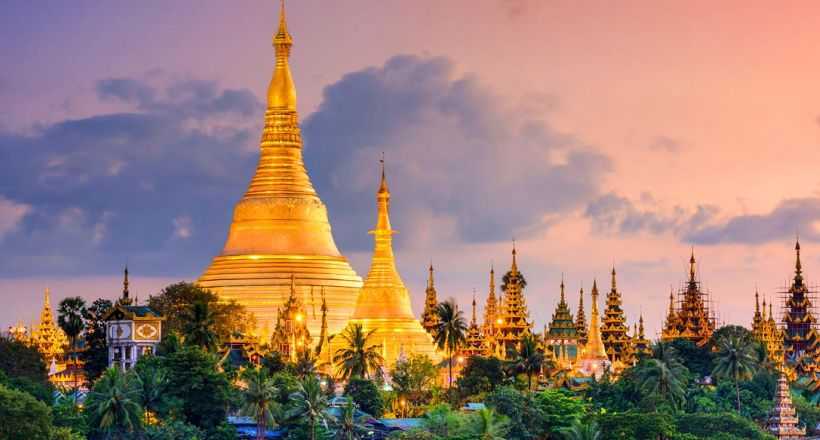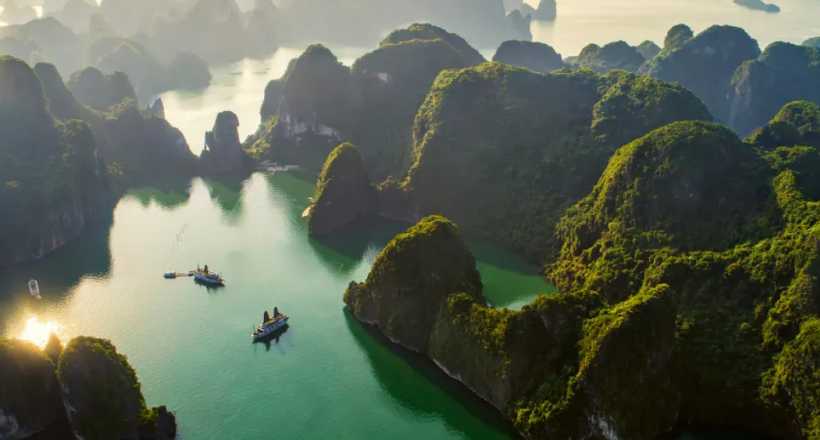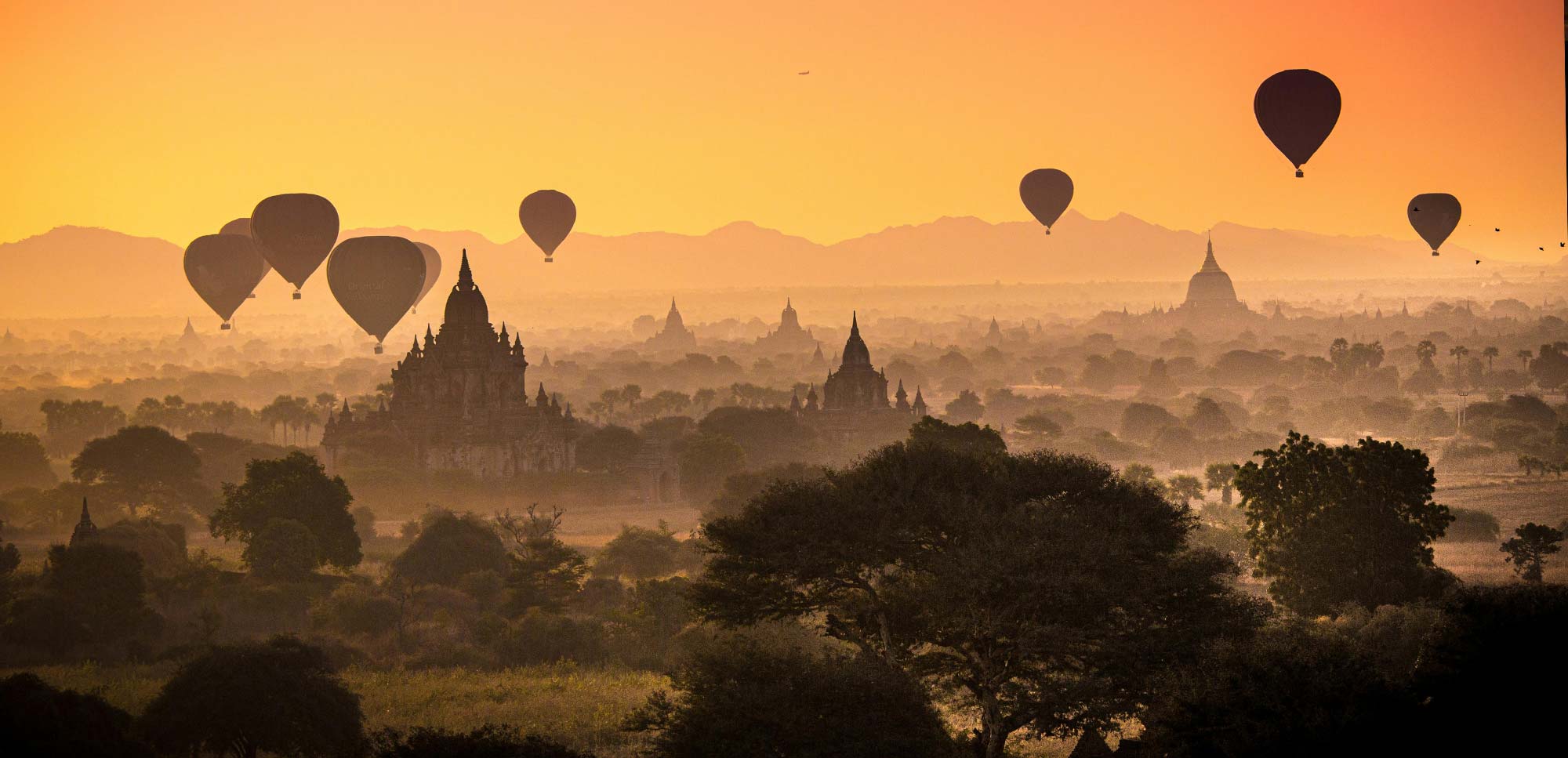
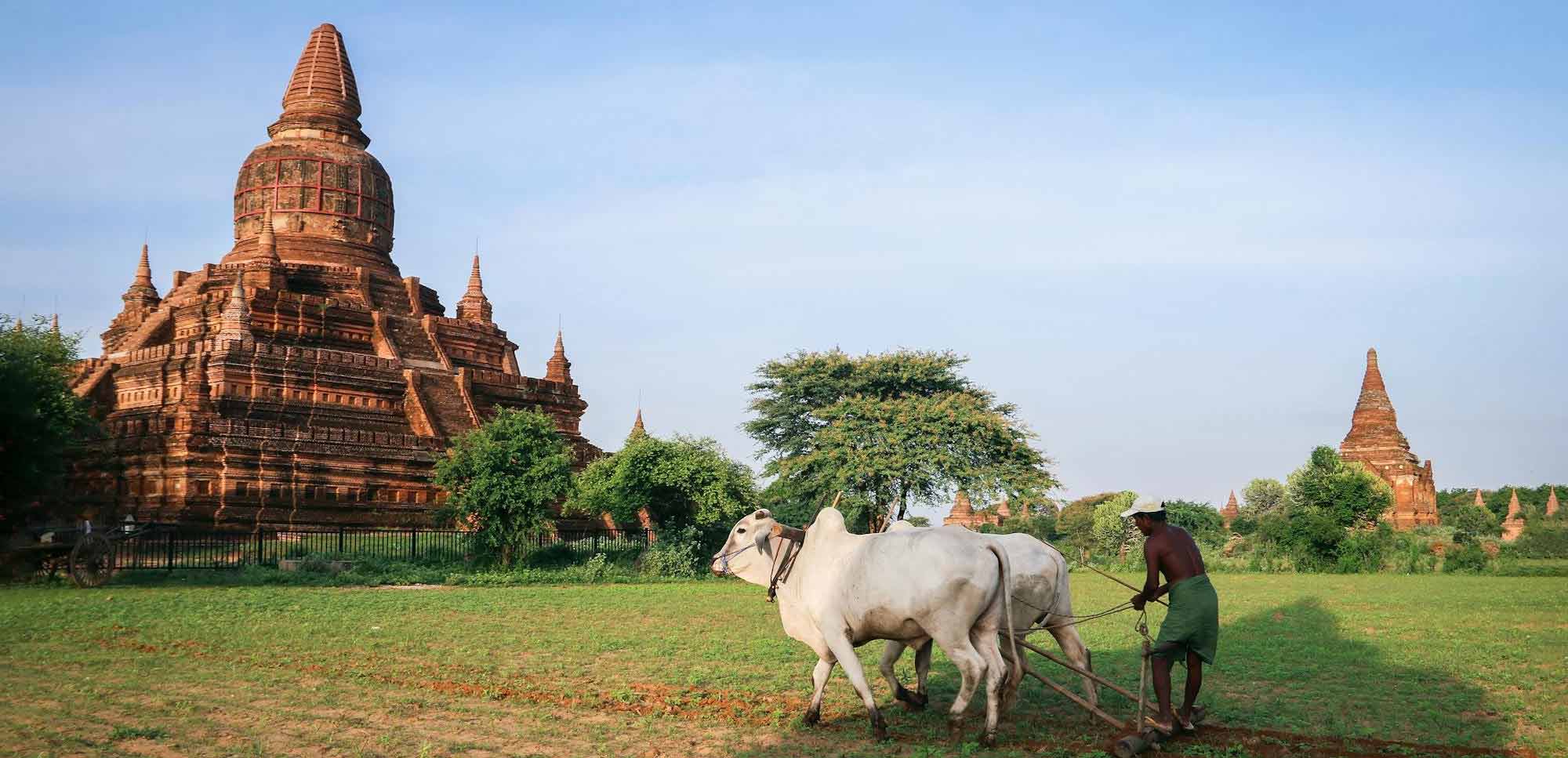
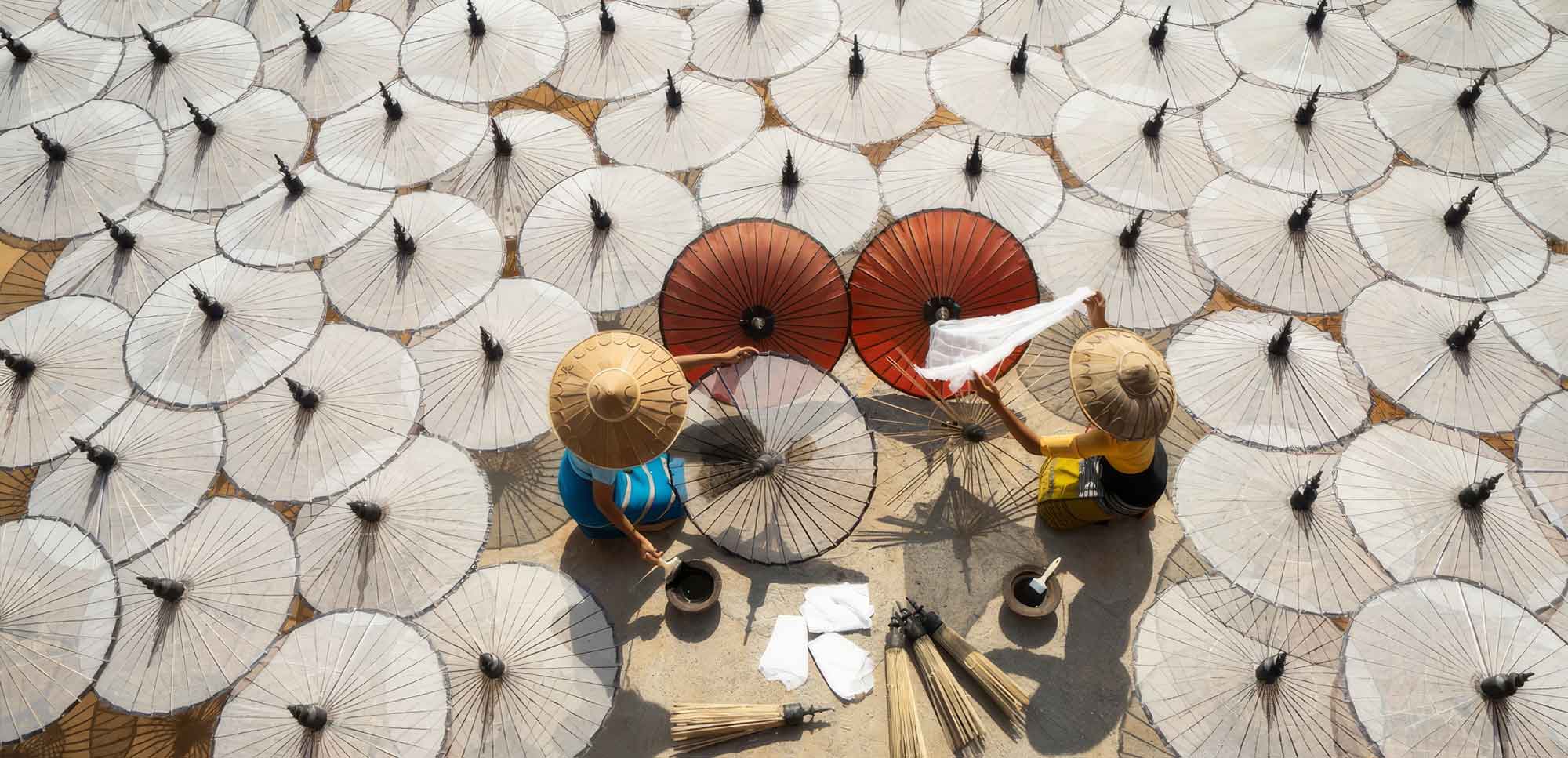
Myanmar
Golden Land


CREATE YOUR OWN TRIP WITH US
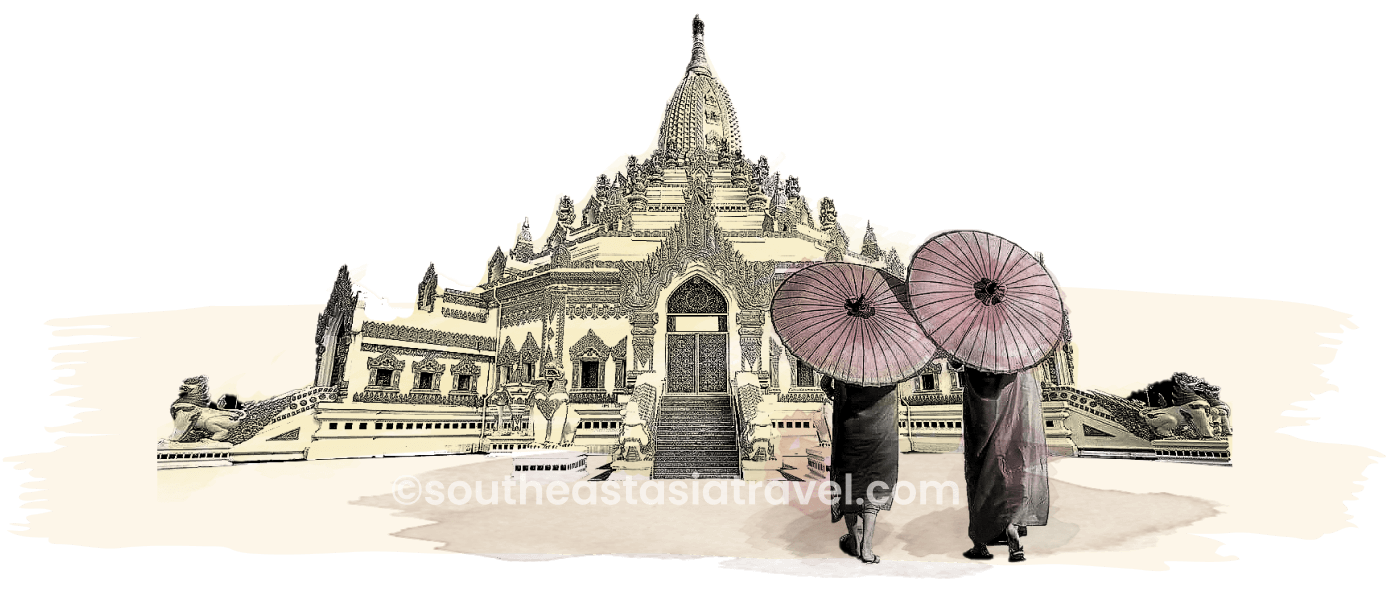
Highlights of Myanmar Tours
As the largest city in the country, Yangon boasts the largest number of colonial-era buildings in Southeast Asia and has a unique colonial-era urban core that is remarkably intact. The colonial-era buildings are centered around Sule Pagoda, the ancient shrine reputed to be over 2,000 years old, located at the very heart of downtown Yangon. The city is also home to the gilded Shwedagon Pagoda, one of Asia’s most impressive Buddhist monuments and Myanmar's most sacred Buddhist pagoda. Nestled right in the heart of the city, this 2,500-year-old stupa is adorned with 27 metric tons of gold leaf along with thousands of gleaming diamonds that make it almost blinding in the sunlight. The interior is minimalistic and eerily quiet, providing a peaceful retreat from the hustle and bustle of Yangon’s streets.
Well known as Myanmar’s premier tourist attraction, Bagan has more than 2,000 temples, pagodas, and stupas that span the vast plains east of the Irrawaddy River. From the town of Nyaung U, one can rattle along the dirt roads in a horse cart to Bagan and float over the temples in a hot air balloon at sunrise for a breath-taking perspective over the sheer scale of this ancient city.
Located on the east bank of the Irrawaddy River, Mandalay was Burma's final royal capital of the Konbaung dynasty before the kingdom's annexation by the British Empire in 1885. Today, Mandalay is the economic center of Upper Myanmar and is considered the center of Burmese culture. Escape the downtown to explore the surrounding towns and villages, stop off to climb to the hilltop pagodas in Sagaing, or take a horse cart around the former capital of Inwa. Back in the city, climb Mandalay Hill at sunset, pausing at the shrines on the way up and taking in a panoramic view from the pagoda at the top.
Gently nestled amid the hills of the Shan Plateau, Inle Lake is one of Myanmar’s greatest natural treasures, giving a glimpse into a distinctive slice of Burmese village life. This is the home of the Intha people, who own the unusual leg-rowing technique immortalized in countless fantastic photos. As the second largest lake in Myanmar, Inle Lake is a peaceful destination to relax and admire stilt houses, floating vegetable gardens, ancient stupas, and monasteries, or simply observe the local fishermen and farmers in their daily lives. Surrounded by a mountainous landscape, Inle Lake is also one of the country’s premier hiking spots. The route between Kalaw and Inle Lake, passing picturesque stilt villages and spectacular viewpoints, is particularly popular.
Home to some of the most secluded and scenic spots for relaxing in Southeast Asia, Ngapali and Ngwe Saung are good choices for a get-away destination with soft white sand, tall coconut palms, and calm turquoise waters ideal for swimming, snorkeling, and kayaking. Spend a few days of sunshine on pristine white-sand beaches to indulge in the slow life and tranquility of this country.
Read more ...
Myanmar RECOMMENDED FOR YOU
Grand Tour of Cambodia, Thailand & Myanmar
Only From $2240 PP
All Inclusive ServiceThis Tour
Grand Tour of Cambodia, Thailand & Myanmar
Only From $2240 PP
All Inclusive ServiceThis Tour
Amazing Myanmar
Only From $2255 PP
All Inclusive ServiceThis Tour
Amazing Myanmar
Only From $2255 PP
All Inclusive ServiceThis Tour
Quintessential Myanmar
Only From $3120 PP
All Inclusive ServiceThis Tour
Quintessential Myanmar
Only From $3120 PP
All Inclusive ServiceThis Tour
Discover Myanmar Culture
Only From $1360 PP
All Inclusive ServiceThis Tour
Discover Myanmar Culture
Only From $1360 PP
All Inclusive ServiceThis Tour
Exotic Malaysia & Myanmar
Only From $2450 PP
All Inclusive ServiceThis Tour
Exotic Malaysia & Myanmar
Only From $2450 PP
All Inclusive ServiceThis Tour
A culture-nature journey to Ngapali Beach
Only From $1280 PP
All Inclusive ServiceThis Tour
A culture-nature journey to Ngapali Beach
Only From $1280 PP
All Inclusive ServiceThis Tour
Cultural Highlights of Myanmar
Only From $990 PP
All Inclusive ServiceThis Tour
Cultural Highlights of Myanmar
Only From $990 PP
All Inclusive ServiceThis Tour
A short escape in Myanmar
Only From $950 PP
All Inclusive ServiceThis Tour
A short escape in Myanmar
Only From $950 PP
All Inclusive ServiceThis Tour
Myanmar Into The Sunlight
Only From $1225 PP
All Inclusive ServiceThis Tour
Myanmar Into The Sunlight
Only From $1225 PP
All Inclusive ServiceThis Tour
Unforgettable Myanmar
Only From $1620 PP
All Inclusive ServiceThis Tour
Unforgettable Myanmar
Only From $1620 PP
All Inclusive ServiceThis Tour
Truly Myanmar
Only From $2850 PP
All Inclusive ServiceThis Tour
Truly Myanmar
Only From $2850 PP
All Inclusive ServiceThis Tour
A magical adventure through Vietnam, Thailand and Myanmar
Only From $3392 PP
All Inclusive ServiceThis Tour
A magical adventure through Vietnam, Thailand and Myanmar
Only From $3392 PP
All Inclusive ServiceThis Tour




Myanmar
What are Myanmar Tours?
Myanmar, also known as Burma, is a Southeast Asian nation celebrated for its rich history, diverse cultures, and stunning landscapes. The "Land of Golden Pagodas," Myanmar offers a blend of spiritual traditions, vibrant markets, and welcoming hospitality. Despite its modern developments, the country retains its timeless charm, making it a captivating destination for travelers seeking unique cultural and natural experiences.
Myanmar Tours are organized travel experiences that showcase the country’s cultural, historical, and natural attractions. These tours typically include visits to major landmarks such as Bagan’s ancient temples, Mandalay’s royal palaces, and the serene Inle Lake. Travelers can choose from private or group tours, with options ranging from cultural immersions and trekking adventures to luxury cruises along the Irrawaddy River. Myanmar Tours provide a guided journey through the nation’s time-honored traditions, vibrant local life, and breathtaking scenery, ensuring a comprehensive and memorable exploration of this enchanting destination.

Travelers often face the choice between private tours and group tours when exploring Myanmar. Each option offers unique benefits and drawbacks, depending on individual preferences and travel goals. Myanmar private tours are ideal for those seeking flexibility, comfort, and a personalized experience, while group tours suit travelers looking for affordability, structure, and social engagement.
Myanmar Private Tours
Myanmar Private Tours offer an exclusive and personalized way to explore the rich cultural heritage, beautiful landscapes, and historic sites of this captivating Southeast Asian destination. Tailored to your interests, these tours allow you to discover Myanmar at your own pace, whether you’re interested in visiting ancient temples in Bagan, cruising the serene waters of Inle Lake, or experiencing the vibrant traditions of local villages. With the expertise of private guides and comfortable transportation, travelers can enjoy a deeper connection to the country’s history, culture, and people. A private tour in Myanmar ensures a unique, hassle-free experience, filled with unforgettable moments.
Advantages of Myanmar Private Tours:
Personalized Itinerary: Myanmar private tours offer flexibility to tailor the itinerary according to your interests, pace, and schedule. Whether you want to spend extra time at Bagan’s temples or immerse yourself in the local life of Inle Lake, the tour can be customized to suit your preferences.
Exclusive Attention: Your guide will give you their whole attention when you go on a private tour. This ensures a deeper understanding of Myanmar’s history, culture, and traditions, as the guide can cater to your specific questions and interests.
Comfort and Privacy: Myanmar private tours provide a more comfortable and intimate experience. You can travel in a private vehicle, avoid crowded places, and enjoy a more relaxed atmosphere.
Ideal for Special Occasions: If you’re celebrating a honeymoon, anniversary, or other special events, a private tour offers a more exclusive and romantic experience.
Disadvantages of Myanmar Private Tours:
Higher Costs: Private tours are generally more expensive due to personalized services and exclusive arrangements.
Less Social Interaction: Traveling privately means fewer opportunities to meet other travelers and share experiences, which some people find less enjoyable.
Myanmar Group Tours
Myanmar Group Tours provide a wonderful opportunity to explore the country’s captivating sights and rich culture with fellow travelers. These tours are designed to offer a well-rounded experience, combining iconic destinations like Bagan, Inle Lake, and Yangon, all while fostering a sense of camaraderie among participants. Group tours are typically guided by knowledgeable local experts who bring the country’s history, traditions, and hidden gems to life. Perfect for those who enjoy shared experiences, group tours offer a chance to meet new people, benefit from group discounts, and travel in comfort, making Myanmar accessible and enjoyable for all.
Advantages of Myanmar Group Tours:
Cost-Effective: Because everyone shares the expense, group tours are usually less expensive, making it a desirable choice for tight-budget tourists.
Social Experience: Group tours offer a chance to meet and interact with fellow travelers. Sharing experiences can enhance the joy of discovery and create lasting memories.
Structured and Organized: Group tours are well-organized, with a fixed schedule ensuring you cover the major attractions efficiently.
Disadvantages of Myanmar Group Tours:
Lack of Flexibility: Group tours follow a fixed itinerary, which might not align with your personal interests or pace. There is little room for spontaneous exploration.
Shared Attention: The guide’s attention is divided among all participants, which might limit personalized insights and interactions.
Crowded Experience: Traveling with a group means sharing transportation, accommodations, and dining spaces, which might compromise privacy and comfort.
Potential for Personality Clashes: Being part of a diverse group can sometimes lead to differences in preferences and personalities, which could impact the overall experience.
Why choose Myanmar Tours?
Myanmar Is The Land Of Breathtaking Ancient Temples
Myanmar is home to some of the most awe-inspiring ancient temples in the world. The city of Bagan, a UNESCO World Heritage Site, is a must-visit destination. With over 2,000 temples scattered across a vast plain, the sunrise and sunset views from hot air balloons or temple tops are unforgettable experiences. Shwedagon Pagoda in Yangon, with its golden spire that gleams in the sunlight, is another architectural marvel that showcases the country’s spiritual heritage.
Burmese People Are Warm And Welcoming
One of the most striking aspects of Myanmar is the warmth and hospitality of its people. Visitors often recount stories of genuine kindness, whether it’s a local sharing directions, a smile from a street vendor, or an invitation to a home-cooked meal. The Burmese people are proud of their culture and eager to share it with curious travelers.
Enjoy Unique Cultural Experiences
Myanmar boasts a rich tapestry of traditions and customs. The country’s festivals, such as the Thingyan Water Festival or the Taunggyi Balloon Festival, offer immersive cultural experiences. Traditional arts like puppet shows, lacquerware crafting, and Thanaka face painting provide insights into Myanmar’s vibrant heritage. Visitors can also witness the serene monastic life at monasteries, where meditation and simplicity are central themes.
Myanmar Is Well-known For Pristine Natural Landscapes
From the tranquil waters of Inle Lake to the pristine beaches of Ngapali, Myanmar’s natural beauty is unparalleled. Inle Lake, with its incredible leg-rowing fishermen and floating houses, offers a serene escape. For those seeking adventure, trekking opportunities abound in the hills of Kalaw and Hsipaw, where visitors can explore verdant landscapes and visit remote ethnic villages.
Savor Delicious And Diverse Food On Myanmar Tours
Myanmar’s cuisine is a delightful fusion of flavors influenced by its neighbors and indigenous ingredients. Don’t miss trying the national dish, mohinga, a savory fish noodle soup, or tea leaf salad (lahpet thoke), a unique blend of flavors and textures. Street food enthusiasts will relish the opportunity to sample freshly prepared snacks like samosas, steamed buns, and rice cakes.
Embark On Off-the-Beaten-Path Adventures
Unlike other Southeast Asian destinations that can be crowded with tourists, Myanmar still feels unspoiled and authentic. Whether exploring the remote Mergui Archipelago, cruising down the Ayeyarwady River, or wandering through markets filled with local goods, Myanmar offers plenty of opportunities for off-the-beaten-path adventures.

Best time to take Myanmar Tours
The best time to visit Myanmar is during the cool season, from November to February, when the weather is most favorable for exploring the country's treasures. However, depending on your interests and tolerance for heat or rain, other seasons may also have their charm.
Myanmar's climate is divided into three main seasons: the cool season, the hot season, and the rainy season.
Cool Season (November to February):
The cool season is widely considered the best time to visit Myanmar. During this period, the weather is pleasant, with temperatures ranging from 20°C to 30°C (68°F to 86°F), making it ideal for exploring outdoor attractions like the temples of Bagan or trekking in Shan State. The skies are clear, which is perfect for photography and hot-air balloon rides over Bagan.
Hot Season (March to May):
Temperatures can soar above 40°C (104°F) during the hot season, especially in central regions like Mandalay and Bagan. While travel is still possible, sightseeing can be challenging due to the heat. However, this is a great time to visit higher-altitude destinations like Pyin Oo Lwin or Kalaw, which remain cooler.
Rainy Season (June to October):
The monsoon season brings heavy rainfall, particularly to coastal areas. While the lush greenery and fewer tourists might appeal to some, travel can be hindered by flooding and muddy roads. However, destinations like Yangon and Mandalay receive less rain, making them relatively accessible.
Special Considerations
- Festivals: Timing your visit to coincide with festivals like Thingyan (the Burmese New Year Water Festival in April) or the Thadingyut Festival of Lights (October) can offer a unique cultural experience.
- Crowds and Costs: The cool season sees a surge in tourists, leading to higher prices for accommodations and tours. Booking in advance is recommended.
What you can expect from Myanmar Tours
- Visit a variety of Yangon's cultural highlights, such as the Chaukhtatgyi Buddha Temple, Bogyoke Aung San Market, and Kandawgyi Lake Park with the giant floating Karaweik Palace, for an intimate glimpse into everyday life in the city.
- Take a slow ride on the Yangon Circular Train that travels around various in-town neighborhoods and town outskirts, where you can catch a glimpse into the colorful daily lives of rural Burmese people and see the real Yangon out of the city.
- Be amazed by the awe-inspiring temple-filled plains of Bagan and see the most popular sights, which are highly significant in Buddhism, such as the beautiful Shwezigone Pagoda, the Ananda Temple, and the Gubyaukgyi Temple.
- Go beyond the most-visited landmarks to the forgotten part of Bagan in Minnathu Village, where you'll see brick monasteries and traditional workshops to uncover the little-known secrets of Myanmar’s architecture and artisanship.
- Cross Inle Lake by boat to witness floating gardens, stilt villages, and the local leg-rowing technique firsthand, and step back on shore to view Nga Phe Kyaung Monastery, Phaung Daw Oo Pagoda, and Shwe Inn Thein Pagoda in Indein Village.
- Visit some world record-breaking sites of the ancient capitals around Mandalay, including the largest pile of bricks, Pahtodawgyi; Mingun Bell, the heaviest bell still in use; the oldest teakwood bridge, U Bein; and Kuthodaw Pagoda with the largest book.
- Uncover the rich culture and heritage of Mandalay and four ancient capitals of Myanmar, including Amarapura, Sagaing, Ava, and Mingun, that are home to some of the country's most impressive religious landmarks, pagodas, and monasteries.
- Join a day trip to the extinct volcano of Mount Popa, considered the home of sacred nats (spirits) by locals, and climb up about 777 steps to the summit, where you will see Taung Kalat Monastery and breathtaking views of the surroundings.
- Uncover the cultural and traditional secrets of Myanmar when you visit several family-run workshops to learn how the locals make the country's exclusive products, such as the famous Shan paper, colorful parasols, and intricate hand-woven silk.
- Experience the Burmese culture and the countryside of Myanmar as you embark on a trekking adventure around Kalaw and to the hill tribes of Danu, Pa-O, Taung Yo, and Palaung people, where you can observe the tradition and their ways of plantation.
- Kick back at Ngwe Saung, a famous untouched beach in southern Myanmar that offers a variety of excitements such as bike tours to fishing villages, snorkeling trips at Bird Island, leisurely walks to Lover's Islands, and lazy days on sun-kissed beaches.
- See a different side of Myanmar on an exciting trekking adventure through tea plantations and fruit farms on Pindaya hillsides to small villages of the Danu tribe, where you can interact with the locals and discover their day-to-day lives.
- Get a chance to experience all of Ngapali at your own pace, such as pedaling along the coastal paths and picturesque villages, visiting local markets, swimming in the warm waters, or spending days lounging on palm-tree-lined beaches.

Most Popular Destinations on Myanmar Tours
Yangon
Yangon, formerly known as Rangoon, is famous for its mix of gorgeous colonial architecture side by side with pagodas covered in gold leaf and studded with jewels. Wander around the city and enjoy delicious street food or visit the more glitzy rooftop bars with a backdrop of glittering monuments and lakes for which Yangon is so famous.
Bagan
Bagan was built around the 12th century and was home to over 20,000 Buddhist pagodas. Now only about 21,000 remain, scattered along the banks of the Ayeyarwady River, beckoning history lovers, architectural enthusiasts, and anyone wanting to go back in time. The best way to experience Bagan is to wake up before sunrise (to avoid the hot sun), cruise around the interweaving dirt roads, and stop at every pagoda that catches your eye.
Mandalay
At the foot of Mandalay Hill, Mandalay is Myanmar’s second-largest city, a charming but convoluted place. It is famous as the old royal capital of Myanmar, home to Burmese kings. The city retains a royal feel with the remains of the palaces, which sets it apart from other cities.
Bago
Bago, also known as Pegu, was once the capital of the Mon Kingdom and one of the ancient cities that flourished on the banks of the Irrawaddy River. While it may be less well known, this city has plenty of culture and history with pagodas, ruins of ancient palaces, and local markets; the city will keep you busy. The town was formerly known as Hanthawaddy and is one of the most abundant archaeological sites in Myanmar.
Ngapali Beach
Situated on the Bay of Bengal in the country’s far west, Ngapali is Myanmar’s best-known beach spot and a real draw for those in search of the perfect place to wind down. Miles of soft white sands, tall coconut palms, and calm turquoise waters are ideal for swimming, snorkeling, and kayaking. Dotted around are picturesque thatched huts, some water sports businesses, and some fantastic seafood eateries.
Kalaw
The town of Kalaw is located atop the beautiful, majestic Shan Hills. It was initially considered a mountain town under former British rule. Owing to its altitude, it was a welcome relief from the scorching Myanmar heat. Hence, it is home to numerous resorts and hotels, together with an amazing food market, and one can go hiking without a permit.
Nyaungshwe
Inle Lake is the second largest natural lake in Myanmar. It is a beautiful highland lake in the middle of the Nyaungshwe Valley of the Shan Plateau between two mountain ranges extending from north to south. Hence, it feels like a different world to the rest of Myanmar. Glide along the lake’s tranquil waters and pass fishermen on their wooden boats and the stilted houses of the Intha people.
Pindaya
Pindaya is one of the off-the-beaten-track sites located in the rise of the majestic Shan Hills, offering a unique glimpse into the nation’s devout Buddhist history. The area was formed from a series of deep caves and is home to over 8,000 statues and images of Buddha in beautiful, glimmering gold and brass.
Hpa-An
Besides the beautiful mountains, lakes, and temples that characterize this region, Hpa-An is home to some of Myanmar’s most impressive caves. Dozens of ancient limestone caves serve as natural Buddhist temple shrines filled with stunning statues, pagodas, and wall carvings. Don't miss the gigantic Sadan Cave, where towering chambers are full of Buddhas, huge stalactites, walls formed from crystals, flocks of bats, and even a hidden internal lake.
Mergui Archipelago
The Mergui Archipelago is located along the southwest coast of Myanmar and is home to more than 800 mostly uninhabited islands, white beaches, and an incredible seabed. It is an extraordinary destination for exploring unspoiled nature, learning about local culture and traditions, relaxing, snorkeling and swimming in the crystal-clear waters of the Andaman Sea.
Ngwe Saung
Ngwe Saung is a less populated beach on the edge of the Bay of Bengal, along with a clutch of pretty coconut groves and five-star resorts. Palm trees, blue seas, and pale sands offer the perfect place to laze the days in the sun. Activities include scuba diving and snorkeling, and there are plenty of cafes and restaurants.
Myanmar Tours by Styles
Myanmar Tours by Styles offer a unique and customizable way to experience the country, tailored to suit various travel preferences and interests. These tours provide a personalized approach, allowing you to explore Myanmar at your own pace and in your preferred style. From spiritual journeys through ancient temples to beach getaways along the coast, Myanmar Tours by Styles ensure that every trip is memorable and aligned with your travel desires.
Myanmar Heritage & Culture Tours
Myanmar Heritage & Culture Tours provide a deep dive into Myanmar's ancient civilizations, allowing travelers to explore UNESCO-listed temples like those in Bagan, visit sacred sites such as the Shwedagon Pagoda, and learn about local traditions that have remained unchanged for centuries. With visits to rural villages, bustling markets, and traditional craft workshops, you can witness firsthand the vibrant customs and artistic expressions of Myanmar’s many ethnic groups. Expert guides give fascinating insights into the country’s Buddhist heritage, local festivals, and unique cultural practices, making these tours a truly immersive experience. Myanmar Heritage & Culture Tours are perfect for those looking to connect with the past while embracing the country’s rich cultural tapestry.
Nature & Wildlife Myanmar Tours
Nature & Wildlife Myanmar Tours are ideal for eco-tourists and wildlife enthusiasts seeking an authentic and environmentally conscious experience, allowing you to connect with nature in one of Asia’s last truly untouched destinations. These tours take you to some of the country’s most beautiful natural reserves, where you can witness vibrant birdlife, exotic plants, and unspoiled landscapes. From lush rainforests to tranquil lakes and pristine beaches, it’s an incredible opportunity to take in Myanmar’s breathtaking natural beauty and diverse ecosystems.
Myanmar Beach & Island Tours
Unlike the crowded beaches of neighboring countries, Myanmar’s shores, such as Ngapali Beach and the Mergui Archipelago, provide tranquil settings perfect for relaxation, adventure, and cultural immersion. With crystal-clear waters, white sandy beaches, vibrant coral reefs, and rich marine life, these destinations are ideal for snorkeling, diving, and island-hopping. Additionally, the opportunity to explore remote fishing villages and connect with local communities adds an authentic touch to your experience. Myanmar Beach & Island Tours offer an idyllic, less-commercialized alternative for those seeking peace, natural beauty, and a more personalized travel experience.

Where to Stay on Myanmar Tours
When touring Myanmar, accommodation options range from budget guesthouses to luxurious hotels, ensuring something for every type of traveler. In major cities like Yangon and Mandalay, you’ll find upscale international hotels with modern amenities, while places like Bagan and Inle Lake offer boutique resorts with scenic views. For a more authentic experience, opt for traditional inns or homestays in rural areas.
Yangon
3.5-star Best Western Chinatown Hotel - No.127-137 Anawrahta Road, Corner of Lanmadaw Road, Latha Township, Yangon
4-star Jasmine Palace Hotel - No.341 Pyay Road, Sanchaung Township, Yangon
5-star Pan Pacific Yangon - Corner of Bogyoke Aung San Road and Shwedagon Pagoda Road, Pabedan Township, Yangon
Bagan
3-star Bagan Thande Hotel - Archaeological Zone, Old Bagan, Bagan
4-star Tharabar Gate Hotel - Near Tharabar Gate, Old Bagan, Bagan
5-star Aureum Palace Hotel & Resort - Min Nanthu Village, Near Bagan Viewing Tower, Nyaung U, Bagan
Mandalay
3-star Hotel by the Red Canal - No. 417 Corner of 63 & 22 Streets, Aung Myae Tha Zan Township, Mandalay
4-star Ease Hotel Mandalay - 30th Street, Between 64th Street & 65th Street, Chan-aye-thar-zan Township, Mandalay
5-star Mingalar Mandalay Hotel - 73rd Street, Between Thazin & Ngu Shwe Wah Streets, Chanmytharzi Township, Mandalay
Inle Lake
3-star Paramount Inle Resort - Nga Phe Chaung Village, Inle Lake, Nyaung Shwe, Taunggyi
4-star Inle Resort & Spa - Myaung Yoe Gyi Village, Inle Lake, Nyaung Shwe Township, Shan State
5-star Sanctum Inle Resort - Maing Thauk Village, Inle Lake, Nyaung Shwe Township, Shan State
Ngwe Saung
4-star Eskala Hotels & Resorts Ngwe Saung - Ngwe Saung Beach, Pathein, Ayeyarwaddy Division
4-star Ngwe Saung Yacht Club & Resort - No.59/63/64 Ngwe Saung Beach, Myo Ma St, Ayeyarwaddy Region
5-star Aureum Palace Hotel & Resort - Ngwe Saung, Village 10271
Kalaw
3-star Kalaw Garden Hotel - No.5 Hinthargone Street, 6 Quarter, Kalaw, Southern Shan State
3-star Dream Mountain Resort - Jo Pyay Yan Pyay Pagoda Street, 10 Quarter, Kalaw
Ngapali Beach
3-star Merciel Retreat & Resort - Ngapali Beach, Zee Phyu Gone Village, Thandwe
4-star Bayview Beach Resort - 205 Hgnet Pyaw Khaung Kwin, Lin Thar, Ngapali, Thandwe
5-star Aureum Palace Hotel & Resort Ngapali - Kan Yeik Thar Road, Mingalar Taung Nyunt Township, Ngapali, Thandwe
Pindaya
3-star Pindaya Inle Inn - Maha Bandoola Road, Pindaya, Southern Shan State
3-star Pindaya Farm House - Pindaya-Heho Road, Thit Al Pin Village, Pindaya Township, Pindaya
Must-try Food on Myanmar Tours
Laphet Thoke - Tea Leaf Salad
Laphet Thoke, or tea leaf salad, is a beloved and iconic dish in Myanmar, offering a unique blend of flavors and textures. At its heart is fermented tea leaves, which provide a distinct, slightly bitter base that is both aromatic and tangy. The salad is typically served with a variety of ingredients such as crispy fried garlic, peanuts, sesame seeds, sliced tomatoes, and shredded cabbage, all tossed together to create a harmonious balance of crunch, umami, and spice. The addition of chili and lime juice brings a zesty kick, making it a refreshing yet complex dish. Often enjoyed as a snack or side dish, Laphet Thoke embodies the cultural essence of Myanmar, reflecting the country's love for bold and layered flavors in everyday cuisine.
Mohinga
Mohinga is often considered Myanmar's national dish, a flavorful and aromatic fish soup that holds a special place in the hearts of the people. Typically eaten for breakfast, Mohinga consists of a rich, fragrant broth made from fish, lemongrass, ginger, garlic, and a variety of spices, often thickened with chickpea flour or rice. The soup is usually served with thin rice noodles, creating a satisfying combination of smooth broth and chewy noodles. Toppings such as crispy fritters, boiled eggs, cilantro, lime, and chili are added to enhance the dish's depth and complexity. The dish is a perfect blend of savory, spicy, and sour flavors, reflecting Myanmar's rich culinary traditions.
Burmese Curry
Burmese curry is a central element of Myanmar’s diverse and flavorful cuisine, known for its rich, aromatic profiles and use of fresh, local ingredients. Unlike its Indian or Thai counterparts, Burmese curry tends to be less fiery but deeply savory, often made with a base of sautéed onions, garlic, ginger, and turmeric, which create a fragrant foundation. The meat, usually chicken, pork, beef, or fish, is simmered in this aromatic mixture with a variety of spices, including cumin, coriander, and chili, and then cooked with vegetables like potatoes, eggplant, and tomatoes. The resulting curry is typically mild but rich in depth and served with fluffy steamed rice to balance the flavors. Depending on the region, Burmese curries can be either thick and stew-like or more soupy, and they often feature a final splash of fish sauce or a squeeze of lime for added brightness.
Shan-Style Rice
Shan-style rice, or Nga Htamin, is a flavorful and aromatic dish originating from the Shan State in Myanmar. It features rice cooked with turmeric, giving it a vibrant yellow color, and is typically paired with oily fish, often tilapia or other local varieties, that have been fried to crispy perfection. The fish is broken into pieces and mixed with the rice, creating a delicious combination of textures and flavors. The dish is usually complemented by a side of pickled vegetables, such as fermented bamboo shoots or pickled mustard greens, adding a tangy contrast to the richness of the rice and fish. Shan-style rice is typically served with a spicy dipping sauce made from chili, garlic, and fermented fish paste, giving it an extra punch of flavor.
Deep Fried Snacks
Deep-fried snacks are a beloved part of Myanmar’s street food culture, offering a variety of delicious and crispy treats that are enjoyed throughout the day. From savory to sweet, these snacks are typically made using simple ingredients but are bursting with flavor. Popular deep-fried items include palata (a flaky, crispy flatbread), samosas filled with spiced potatoes or minced meat, and gyaw, which are small dough balls often filled with sweet or savory fillings like mung beans or pork. Shwe Htamin, deep-fried rice cakes, is also a favorite, offering a crunchy exterior with a soft, savory center. Burmese deep-fried snacks are often paired with a tangy dipping sauce or served alongside a refreshing drink like tea. These treats are commonly sold at markets, food stalls, and roadside carts, providing a quick and satisfying bite for locals and visitors alike.
Nan Gyi Thoke
Nan Gyi Thoke is a traditional Burmese noodle salad that is both comforting and satisfying, making it a popular dish for breakfast or lunch. This flavorful salad features thick, round rice noodles that are tossed with a rich, savory sauce made from fermented soybeans, turmeric, and chili oil, giving it a distinctive yellow hue and a complex depth of flavor. The dish is typically topped with sliced boiled eggs, crispy fried shallots, and fresh vegetables like cucumber, cilantro, and lime for added crunch and freshness. Often, a sprinkle of chili flakes or a dash of fish sauce is added to enhance the flavor and heat. Sometimes, pieces of chicken or pork are mixed in, making it a more hearty version.

Local Festivals and Events for Myanmar Tours
Thingyan (Myanmar New Year Water Festival)
When: Mid-April (based on the traditional Burmese calendar)
Where: Nationwide
What: A nationwide water festival marking the Burmese New Year. People splash water on one another to wash away sins and bad luck, accompanied by music, dancing, and street celebrations.
Thingyan, the Myanmar New Year Water Festival, is one of the most vibrant and eagerly anticipated celebrations in the country, marking the beginning of the Burmese New Year and the start of the monsoon season. Held over several days in mid-April, Thingyan is a joyous occasion filled with lively water fights, traditional rituals, and cultural performances. The festival is rooted in Buddhist traditions, symbolizing the cleansing of sins and the welcoming of a fresh start.
During the celebration, people take to the streets armed with water guns, hoses, and buckets, joyfully splashing water on each other, symbolizing the washing away of bad luck and misfortune. In addition to the playful water battles, Thingyan is a time for families and communities to come together, visit pagodas, offer prayers, and make donations to monks. Traditional music, dances, and performances, including the famous Thingyan songs—upbeat tunes filled with social and political satire—add to the festive atmosphere. The streets are lined with stages for performers, food stalls offering delicious treats like mont let saung (sweet rice cakes), and crowds of people celebrating in the hot April sun.
Phaung Daw Oo Pagoda Festival
When: September/October
Where: Inle Lake, Shan State
What: A 17-day festival where sacred Buddha images from the Phaung Daw Oo Pagoda are paraded on a royal barge around Inle Lake.
The Phaung Daw Oo Pagoda Festival, one of the most significant religious and cultural events in Myanmar, takes place annually in the Inle Lake region of Shan State. Celebrated in honor of the Phaung Daw Oo Pagoda, which houses revered Buddhist relics, the festival is a grand display of devotion, tradition, and community spirit.
During the event, five sacred golden Buddha images are paraded around the lake in a grand procession on a beautifully decorated boat, carried by a flotilla of smaller boats rowed by local villagers dressed in traditional attire. The procession is accompanied by rituals, prayers, and music, drawing thousands of devotees and tourists alike. The festival, which usually spans over several days, also features colorful cultural performances, traditional dances, and a lively marketplace, creating a festive atmosphere that reflects the rich cultural heritage of the Shan people. Pilgrims travel from across Myanmar to participate, offering gifts and prayers in the hope of receiving blessings for prosperity and well-being.
Taunggyi Balloon Festival
When: November (during Tazaungdaing)
Where: Taunggyi, Shan State
What: A spectacular event featuring competitions to release elaborate hot air balloons, often lit with candles or fireworks.
The Taunggyi Balloon Festival, held annually in the city of Taunggyi in Shan State, is one of Myanmar's most visually spectacular and culturally significant events.
Typically celebrated during the Tazaungdaing Festival in November, which marks the end of the rainy season and the beginning of the harvest, the Balloon Festival is a vibrant display of light, color, and tradition. The highlight of the event is the release of large, intricately crafted hot-air balloons, some of which are adorned with dazzling lights, fireworks, and elaborate designs. These balloons, often made from bamboo and paper, soar high into the night sky, accompanied by bursts of fireworks that light up the surroundings, creating a breathtaking sight.
In addition to the balloons, the festival features lively cultural performances, traditional music, and food stalls, making it a festive occasion that attracts both locals and visitors from around the world. The Taunggyi Balloon Festival is not only a celebration of the harvest but also a way for the local communities to express their creativity, devotion, and unity, as many of the balloons are launched as offerings to the Buddha.
Kason Festival (Buddha Day)
When: May (full moon of Kason)
Where: Nationwide
What: Commemorating the Buddha’s birth, enlightenment, and passing away. Devotees pour water on the Bodhi tree as a mark of reverence.
The Kason Festival, also known as Buddha Day, is a significant religious celebration in Myanmar, commemorating the birth, enlightenment, and death anniversary of the Buddha, all of which are believed to have occurred during the month of Kason in the Buddhist lunar calendar (usually in May).
This deeply spiritual festival centers around the ritual of "watering the Buddha," a tradition symbolizing reverence and gratitude. Devotees will visit pagodas across the nation and douse the Buddha statues with water, signifying the purification of sins and the cultivation of virtue and knowledge. The act of watering is also a metaphor for spiritual growth, as it is believed to bring good fortune, prosperity, and peace. In addition to the water-pouring ritual, many people make offerings of flowers, candles, and incense at the pagodas while monks perform prayers and chants. The Kason Festival is also a time for community gatherings, with families coming together to share meals, engage in acts of charity, and reflect on the Buddha’s teachings.
Shan New Year Festival
When: December (based on the Shan lunar calendar)
Where: Shan State and other Shan communities
What: Celebrating the Shan ethnic New Year with dances, music, and feasts
The Shan New Year Festival, celebrated by the Shan ethnic group in Myanmar, is one of the country’s most vibrant and culturally rich festivities, usually taking place in November. The Shan people celebrate the event to commemorate their customs, families, and communities as it signifies the conclusion of the harvest season and the start of a new year. The celebration is filled with colorful events, including traditional music, dancing, and theatrical performances. One of the highlights of the festival is the sein thong, or "cultural exchange," where people from different Shan communities gather to showcase their unique cultural practices, music, and dances.
A central part of the festivities is the preparation of festive foods, such as Shan-style rice, and the sharing of meals among family and friends. People also engage in ritual offerings at temples and pagodas to seek blessings for the coming year. Traditional Shan clothing, often adorned with intricate patterns and embroidery, is worn by many, adding to the festive atmosphere. The Shan New Year Festival is not only a time of joyous celebration but also a reflection of the Shan people’s deep cultural heritage, marked by a spirit of togetherness, respect for ancestors, and gratitude for the bounties of the land.
Myanmar Tours by Durations - Iconic Schedules
Whatever your schedule, Myanmar Tours by Durations provide customized itineraries that ensure a fulfilling and memorable journey, tailored to your time constraints. For those with limited time, shorter tours focus on iconic highlights like Bagan, Yangon, and Inle Lake, allowing you to experience the best of Myanmar in a few days. Longer tours, on the other hand, offer a deeper dive into the country's diverse regions, including remote areas like the Mergui Archipelago or Shan State.
Myanmar Tours 2-5 Days
Myanmar Tours 2-5 Days are perfect for travelers with limited time who still want to experience the country’s rich culture and iconic landmarks. These short trips are ideal for those visiting Myanmar on a business trip, a stopover, or anyone seeking a quick escape. With carefully curated itineraries, travelers can explore top destinations like Yangon’s Shwedagon Pagoda, the ancient temples of Bagan, and the serene beauty of Inle Lake, all in a condensed yet fulfilling timeframe.
Myanmar Tours 2-5 Days Examples:
- A short escape in Myanmar - 5 Days
Myanmar Tours 6-10 Days
Perfect for those seeking a well-rounded and enriching travel experience, Myanmar Tours 6-10 Days strike a great balance between time and exploration. With a longer duration, these tours allow you to experience more of Myanmar’s iconic sites. You’ll also have the chance to visit off-the-beaten-path destinations, meet local communities, and immerse yourself in the rich history and traditions of Myanmar.
Myanmar Tours 6-10 Days Examples:
- Cultural Highlights of Myanmar - 6 Days
- Myanmar Into The Sunlight - 7 Days
- A culture-nature journey to Ngapali Beach - 8 Days
- Unforgettable Myanmar - 9 Days
- A Unique Journey Through Myanmar - 10 Days
Myanmar Tours 11-16 Days
Myanmar Tours 11-16 Days provide a comprehensive and leisurely exploration of Myanmar, ideal for travelers wanting to fully appreciate the country's beauty and culture. With more time to delve deeper into Myanmar's history, these extended tours take you beyond the popular destinations to off-the-beaten-path areas like the Mergui Archipelago, Chin State, and the untouched villages of the Shan Hills to experience Myanmar's authentic rural life, vibrant local festivals, and diverse ethnic communities.
Myanmar Tours 11-16 Days Examples:
- Amazing Myanmar - 11 Days
- Truly Myanmar - 15 Days
- Quintessential Myanmar - 16 Days
Myanmar Tours 16+ Days
Myanmar Tours 16+ Days offer an extensive and in-depth exploration of Myanmar while also providing the unique opportunity to connect the country with neighboring destinations in Southeast Asia. By combining the rich historical sites of Myanmar with the vibrant cities of Bangkok, Luang Prabang, or Siem Reap, travelers can enjoy a seamless blend of diverse experiences while gaining a deeper understanding of the region's shared cultural ties and wonderful nature.
Myanmar Tours 16+ Days Examples:
- Best of Vietnam, Thailand & Myanmar - 17 Days
- Authentic Highlights of Vietnam, Cambodia, Thailand & Myanmar - 17 Days
- Enchanting journey to Vietnam, Thailand and Myanmar - 20 Days

How Much for a Myanmar Tour Package?
Myanmar tour packages generally fall into three categories: economy, deluxe, and luxury. Here's a guide to help you understand how much you can expect to spend on each option.
Economy Myanmar Tours
Price Range: US$160 - US$180 per day (per person)
Perfect for budget-conscious travelers, Economy Myanmar Tours offer an affordable yet immersive way to see Myanmar. These tours focus on providing value for money, with budget-friendly accommodations, local transportation, and guided experiences to iconic sites.
Example Tour: A private 5-day economy tour of Yangon and Bagan, with 3-star hotels, might cost around US$800 - US$900 per person.
Deluxe Myanmar Tours
Price Range: US$190 - US$210 per day (per person)
Deluxe Myanmar Tours are designed for those seeking a comfortable experience in Myanmar, with stays at mid-range hotels and resorts, exclusive tours, and private guides who provide in-depth insights into the country’s culture, history, and landmarks, ensuring a more intimate and sophisticated journey.
Example Tour: A private 7-day deluxe tour of Mandalay, Bagan, and Yangon, with 4-star accommodations and guided tours, might cost between US$1,400 and US$1,500 per person.
Luxury Myanmar Tours
Price Range: US$220 - US$290+ per day (per person)
Crafted for discerning travelers, Luxury Myanmar Tours feature stays at luxurious hotels and resorts, private guided excursions, and seamless transportation, ensuring every detail is taken care of. It allows you to immerse yourself in the country’s beauty and heritage while enjoying the highest level of comfort and sophistication.
Example Tour: A private 10-day luxury tour that includes stays at 5-star hotels in Yangon, Mandalay, and Bagan; luxury resorts in Inle Lake; and private guided tours could range from US$2,200 to US$2,900+ per person.
Factors Affecting Myanmar Tour Prices
Seasonality: Prices tend to be higher during the peak season (November to February) due to favorable weather.
Destinations: Including remote or less-visited areas may increase costs due to transportation and accommodation challenges.
Customization: Tailor-made itineraries with unique experiences generally cost more than standard packages.
Frequently Asked Questions about Myanmar Tours
Do I need a visa to travel to Myanmar?
While travelers from some countries (Brunei, Cambodia, Indonesia, Laos, the Philippines, Thailand, and Vietnam) do not require a visa to Myanmar for a period of 14-30 days, most nationalities will need a tourist visa to enter the country.
There are two ways to get a Myanmar visa:
- Option 1: Apply from an Embassy or Consulate
- Option 2: Apply online at the official website.
Please note: There are 100 countries eligible to apply for the Myanmar tourist eVisa.
Is it safe to travel to Myanmar?
Myanmar is a safe place to visit, but it's important to take some normal precautions. We recommend that you take a taxi instead of walking at night. Before you start your journey with a driver, you should negotiate the fare in advance. Remember to give the driver your hotel's card if you want to pay the correct price.
What about food and drink in Myanmar?
About food: The food in Myanmar is influenced by Indian and Chinese cuisines. Curries and soups consist of basic ingredients of the local diet. Specialties are different in regions. The most well-liked dish is Mohingal, which includes rice noodles in a fish soup/broth served with fish cakes and donuts.
About drink: It is strongly recommended NOT to drink tap water in Myanmar. You should bring your own reusable water bottle and water purifier rather than buying bottled water.
Is there internet service in Myanmar?
Internet service and Wi-Fi connections are available in most hotels in major cities: Yangon, Bagan, and Mandalay. However, the speed is very slow and unreliable, especially in the countryside.
Can I use my cell phone in Myanmar?
You should ask your mobile carrier about coverage in Myanmar. If they provide service there, it might be expensive. It’s better to have a local SIM card, though there is no coverage in remote areas.
What should I wear to visit Myanmar?
Myanmar is mostly a Buddhist country, and tourists are always welcome to visit temples and monasteries. However, it is essential to remember some basic rules about etiquette and protocol:
- Wear suitable clothes and behave politely when visiting religious sites.
- Avoid wearing shorts or tank tops, and be sure to keep shoulders and knees covered.
- Take off hat and shoes when entering a temple or monastery.
- Never point your finger or the bottom of your feet towards someone or a Buddha statue.
What currency is used in Myanmar? Are credit cards used in Myanmar?
You can use US dollars in many places, but torn notes and coins are not accepted. This means you should have some cash in the local currency (Kyat). Some tourist places may use the euro too.
Credit and debit cards can be used to withdraw money and make purchases in major cities. In remote rural areas, you should bring cash in small notes.
Should I arrange travel insurance?
Yes. It's always a good idea to have insurance that covers you for any medical issues, delays, or problems during your vacation.
Do I need any special vaccinations?
Always consult your physician before your trip to know if you need any special vaccinations or medication when visiting Myanmar.
Should I tip in Myanmar?
Tipping is not compulsory, but it will not be refused.
Myanmar Destinations
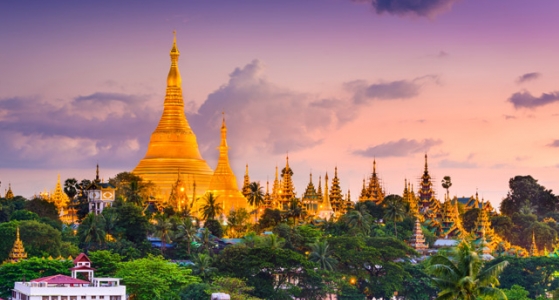
Yangon, formerly known as Rangoon, is famous for its mix of gorgeous colonial architecture side by side with pagodas covered in gold leaf and studded with jewels. Wander around the city and enjoy delicious street food, or visit the more glizzy rooftop bars with a backdrop of glittering monuments and lakes for which Yangon is so famous.
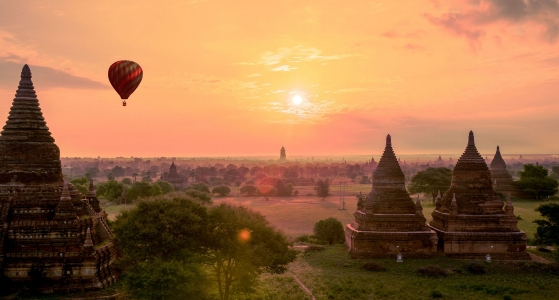
Bagan was built around the 12th century and was home to over 20,000 Buddhist pagodas. Now only about 21,000 remain, scattered along the banks of the Ayeyarwady River, beckoning history lovers, architectural enthusiasts, and anyone wanting to go back in time. The best way to experience Bagan is to wake up before sunrise (to avoid the hot sun), cruise around the interweaving dirt roads, and stop at every pagoda that catches your eye.
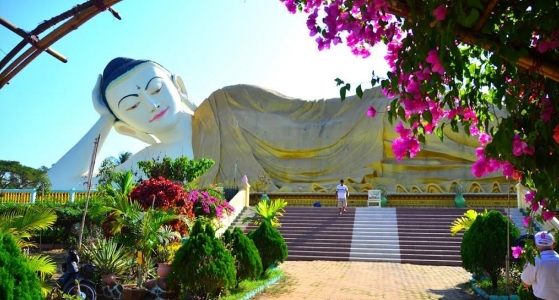
Bago, also known as Pegu, was once the capital of the Mon Kingdom and one of the ancient cities that flourished on the banks of the Irrawaddy River. While it may be less well known, this city has plenty of culture and history. With pagodas, ruins of ancient palaces, and local markets, the city will keep you busy. The town was formerly known as Hanthawaddy and is one of the most abundant archaeological sites in Myanmar.
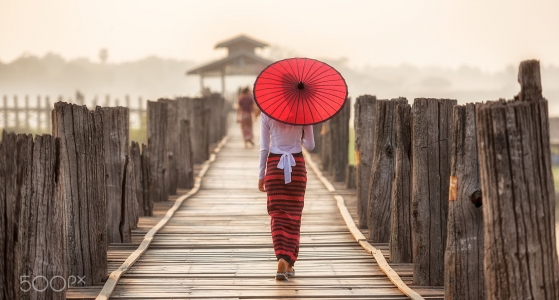
At the foot of Mandalay Hill, Mandalay is Myanmar’s second-largest city, a charming but convoluted place. It is famous as the old royal capital of Myanmar, home to Burmese kings. The city retains a royal feel with the remains of the palaces, which sets it apart from other cities.
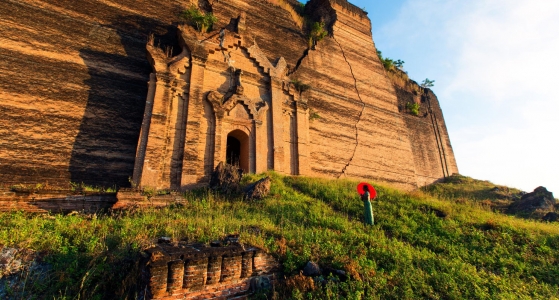
Mingun is an ancient village located upstream of the Ayeyarwady River. Here is the Mingun Pahtodawgyi—what might have been the world’s largest Buddhist temple, if only it had been completed. Interestingly, this monument was left unfinished on purpose due to a prophecy that proclaimed that on the day of its completion, the king would die and his entire kingdom would fall.
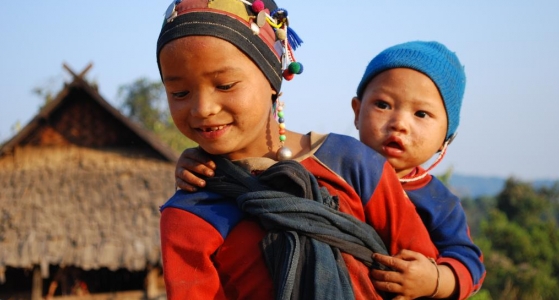
The town of Kalaw is located atop the beautiful, majestic Shan Hills. It was initially considered a mountain town under former British rule. Owing to its altitude, it was a welcome relief from the scorching Myanmar heat. Hence, it is home to numerous resorts and hotels, together with an amazing food market, and one can go hiking without a permit.
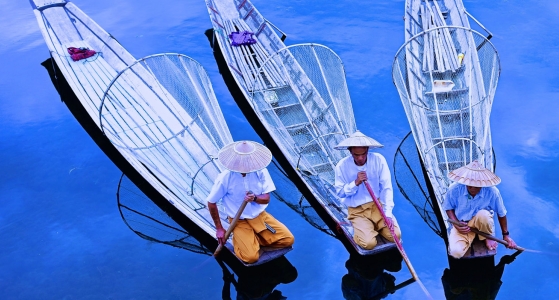
Inle Lake is the second-largest natural lake in Myanmar. It is a beautiful highland lake in the middle of the Nyaungshwe Valley of the Shan Plateau, between two mountain ranges extending from north to south. Hence, it feels like a different world from the rest of Myanmar. Glide along the lake’s tranquil waters and pass fishermen on their wooden boats and the stilted houses of the Intha people.
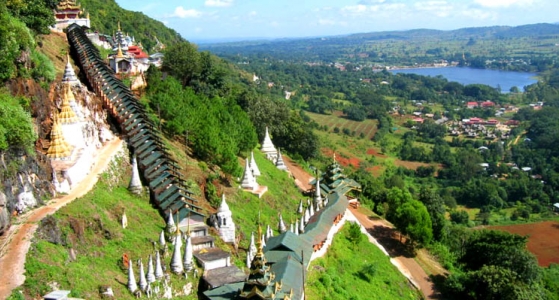
Pindaya is one of the off-beaten-track sites located on the rise of the majestic Shan Hills, offering a unique glimpse into the nation’s devout Buddhist history. The area was formed from a series of deep caves and is home to over 8,000 statues and images of Buddha in beautiful, glimmering gold and brass.
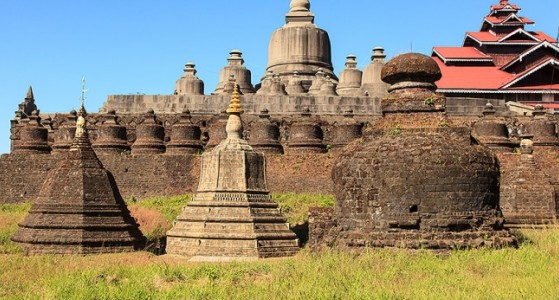
Mrauk U is the second most famous archaeological site in the country; it is similar to Bagan but without being overwhelmed by tourists. It is also a lot more difficult to reach, as it is situated in northern Rakhine State. The lack of tourists isn’t the only difference between Mrauk U and Bagan; the pagodas are also quite different. Those in Mrauk U have thick walls built of stone, rather than brick, to withstand fierce winds. And they are also smaller and newer than those in Bagan.
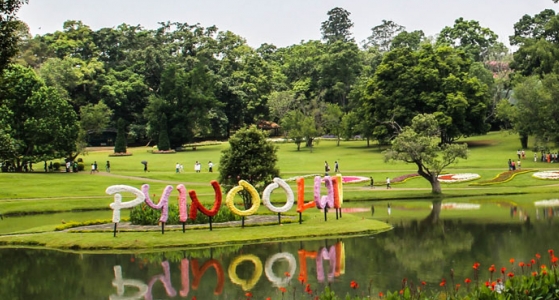
Pyin U Lwin is a scenic hill town that once was the summer retreat of the British Raj and the military base of the Indian Army in the 19th century. This small town is surrounded by botanical gardens, strawberry fields, and coffee bean plantations; trek to nearby waterfalls; taste local wine; and indulge your sweet tooth at one of the many Indian-owned sweet shops. A visit to the National Landmarks Garden is a must.
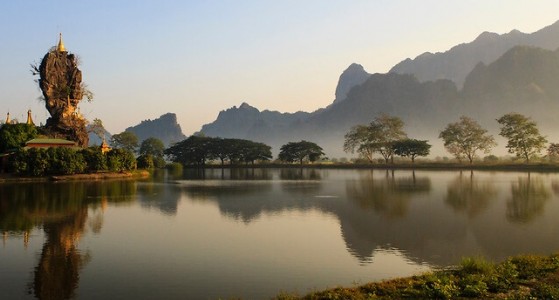
Besides the beautiful mountains, lakes, and temples that characterize this region, Hpa-An is home to some of Myanmar’s most impressive caves. Dozens of ancient limestone caves serve as natural Buddhist temple shrines filled with stunning statues, pagodas, and wall carvings. Don't miss the gigantic Sadan Cave, where towering chambers are full of Buddhas, huge stalactites, walls formed from crystals, flocks of bats, and even a hidden internal lake.
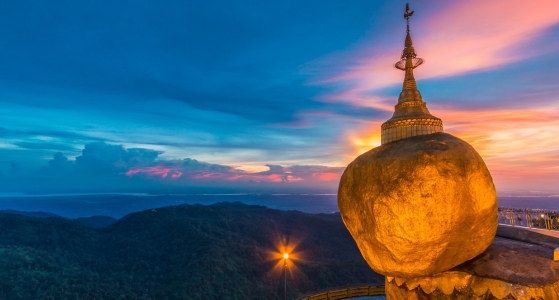
Mount Kyaiktiyo is home to the famous golden rock and gilded pagoda, one of the most sacred sites in Myanmar and a popular pilgrimage spot. This enormous golden rock teeters precariously on the edge of a cliff and is said to be held in place by the hair of Buddha. Kyaiktiyo is accessible by taking an open-top truck, a cable car, or a 4-hour hike to the top.
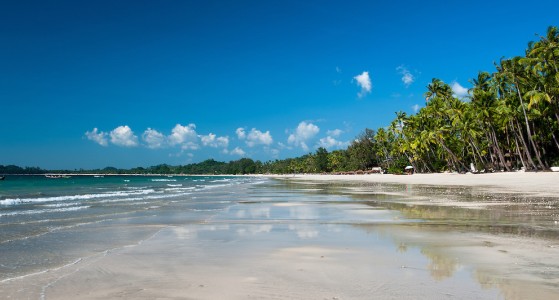
Situated on the Bay of Bengal in the country’s far west, Ngapali is Myanmar’s best-known beach spot and a real draw for those in search of the perfect place to wind down. Miles of soft white sands, tall coconut palms, and calm turquoise waters are ideal for swimming, snorkeling, and kayaking. Dotted around are picturesque thatched huts, some water sports businesses, and some fantastic seafood eateries.
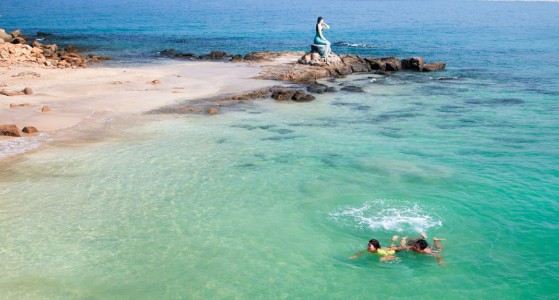
Ngwe Saung is a less-populated beach on the edge of the Bay of Bengal, along with a clutch of pretty coconut groves and five-star resorts. Palm trees, blue seas, and pale sands offer the perfect place to laze the days in the sun. Activities include scuba diving and snorkeling, and there are plenty of cafes and restaurants.
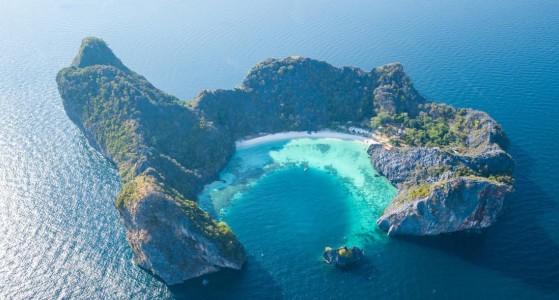
The Mergui Archipelago is located along the southwest coast of Myanmar and is home to more than 800 mostly uninhabited islands, white beaches, and an incredible seabed. It is an extraordinary destination for exploring unspoiled nature, learning about local culture and traditions, relaxing, snorkeling, and swimming in the crystal-clear waters of the Andaman Sea.

Yangon, formerly known as Rangoon, is famous for its mix of gorgeous colonial architecture side by side with pagodas covered in gold leaf and studded with jewels. Wander around the city and enjoy delicious street food, or visit the more glizzy rooftop bars with a backdrop of glittering monuments and lakes for which Yangon is so famous.

Bagan was built around the 12th century and was home to over 20,000 Buddhist pagodas. Now only about 21,000 remain, scattered along the banks of the Ayeyarwady River, beckoning history lovers, architectural enthusiasts, and anyone wanting to go back in time. The best way to experience Bagan is to wake up before sunrise (to avoid the hot sun), cruise around the interweaving dirt roads, and stop at every pagoda that catches your eye.

Bago, also known as Pegu, was once the capital of the Mon Kingdom and one of the ancient cities that flourished on the banks of the Irrawaddy River. While it may be less well known, this city has plenty of culture and history. With pagodas, ruins of ancient palaces, and local markets, the city will keep you busy. The town was formerly known as Hanthawaddy and is one of the most abundant archaeological sites in Myanmar.

At the foot of Mandalay Hill, Mandalay is Myanmar’s second-largest city, a charming but convoluted place. It is famous as the old royal capital of Myanmar, home to Burmese kings. The city retains a royal feel with the remains of the palaces, which sets it apart from other cities.

Mingun is an ancient village located upstream of the Ayeyarwady River. Here is the Mingun Pahtodawgyi—what might have been the world’s largest Buddhist temple, if only it had been completed. Interestingly, this monument was left unfinished on purpose due to a prophecy that proclaimed that on the day of its completion, the king would die and his entire kingdom would fall.

The town of Kalaw is located atop the beautiful, majestic Shan Hills. It was initially considered a mountain town under former British rule. Owing to its altitude, it was a welcome relief from the scorching Myanmar heat. Hence, it is home to numerous resorts and hotels, together with an amazing food market, and one can go hiking without a permit.

Inle Lake is the second-largest natural lake in Myanmar. It is a beautiful highland lake in the middle of the Nyaungshwe Valley of the Shan Plateau, between two mountain ranges extending from north to south. Hence, it feels like a different world from the rest of Myanmar. Glide along the lake’s tranquil waters and pass fishermen on their wooden boats and the stilted houses of the Intha people.

Pindaya is one of the off-beaten-track sites located on the rise of the majestic Shan Hills, offering a unique glimpse into the nation’s devout Buddhist history. The area was formed from a series of deep caves and is home to over 8,000 statues and images of Buddha in beautiful, glimmering gold and brass.

Mrauk U is the second most famous archaeological site in the country; it is similar to Bagan but without being overwhelmed by tourists. It is also a lot more difficult to reach, as it is situated in northern Rakhine State. The lack of tourists isn’t the only difference between Mrauk U and Bagan; the pagodas are also quite different. Those in Mrauk U have thick walls built of stone, rather than brick, to withstand fierce winds. And they are also smaller and newer than those in Bagan.

Pyin U Lwin is a scenic hill town that once was the summer retreat of the British Raj and the military base of the Indian Army in the 19th century. This small town is surrounded by botanical gardens, strawberry fields, and coffee bean plantations; trek to nearby waterfalls; taste local wine; and indulge your sweet tooth at one of the many Indian-owned sweet shops. A visit to the National Landmarks Garden is a must.

Besides the beautiful mountains, lakes, and temples that characterize this region, Hpa-An is home to some of Myanmar’s most impressive caves. Dozens of ancient limestone caves serve as natural Buddhist temple shrines filled with stunning statues, pagodas, and wall carvings. Don't miss the gigantic Sadan Cave, where towering chambers are full of Buddhas, huge stalactites, walls formed from crystals, flocks of bats, and even a hidden internal lake.

Mount Kyaiktiyo is home to the famous golden rock and gilded pagoda, one of the most sacred sites in Myanmar and a popular pilgrimage spot. This enormous golden rock teeters precariously on the edge of a cliff and is said to be held in place by the hair of Buddha. Kyaiktiyo is accessible by taking an open-top truck, a cable car, or a 4-hour hike to the top.

Situated on the Bay of Bengal in the country’s far west, Ngapali is Myanmar’s best-known beach spot and a real draw for those in search of the perfect place to wind down. Miles of soft white sands, tall coconut palms, and calm turquoise waters are ideal for swimming, snorkeling, and kayaking. Dotted around are picturesque thatched huts, some water sports businesses, and some fantastic seafood eateries.

Ngwe Saung is a less-populated beach on the edge of the Bay of Bengal, along with a clutch of pretty coconut groves and five-star resorts. Palm trees, blue seas, and pale sands offer the perfect place to laze the days in the sun. Activities include scuba diving and snorkeling, and there are plenty of cafes and restaurants.

The Mergui Archipelago is located along the southwest coast of Myanmar and is home to more than 800 mostly uninhabited islands, white beaches, and an incredible seabed. It is an extraordinary destination for exploring unspoiled nature, learning about local culture and traditions, relaxing, snorkeling, and swimming in the crystal-clear waters of the Andaman Sea.

Customize Myanmar


Adventure Travel Trade Association


American Society of Travel Agents
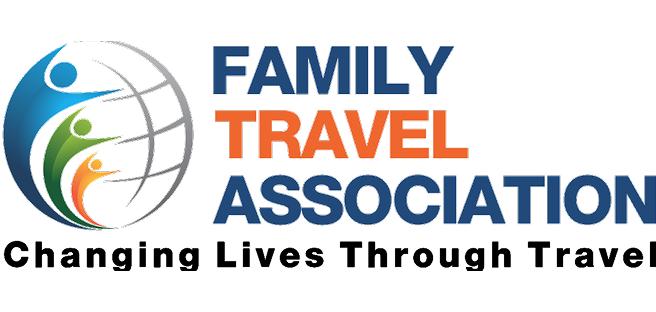
Family Travel Association


TripAdvisor


Wikipedia


World Travel Awards
With over 15 years of experience in the tourism field, Southeast Asia Travel company has built a solid reputation as experts in designing custom tours across Southeast Asia: Vietnam, Laos, Cambodia, Thailand, Singapore, Malaysia, Indonesia, Myanmar, Philippines... Read more
